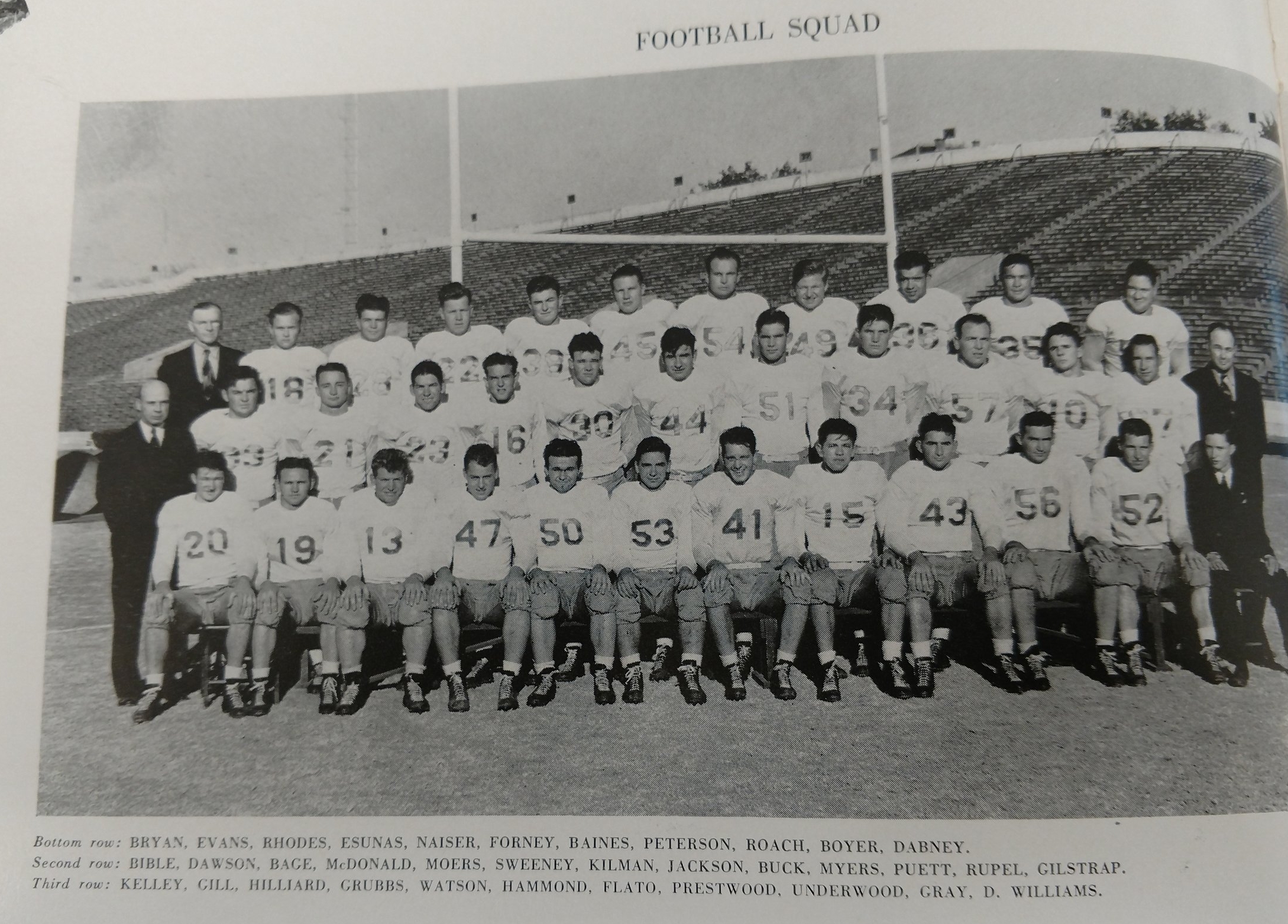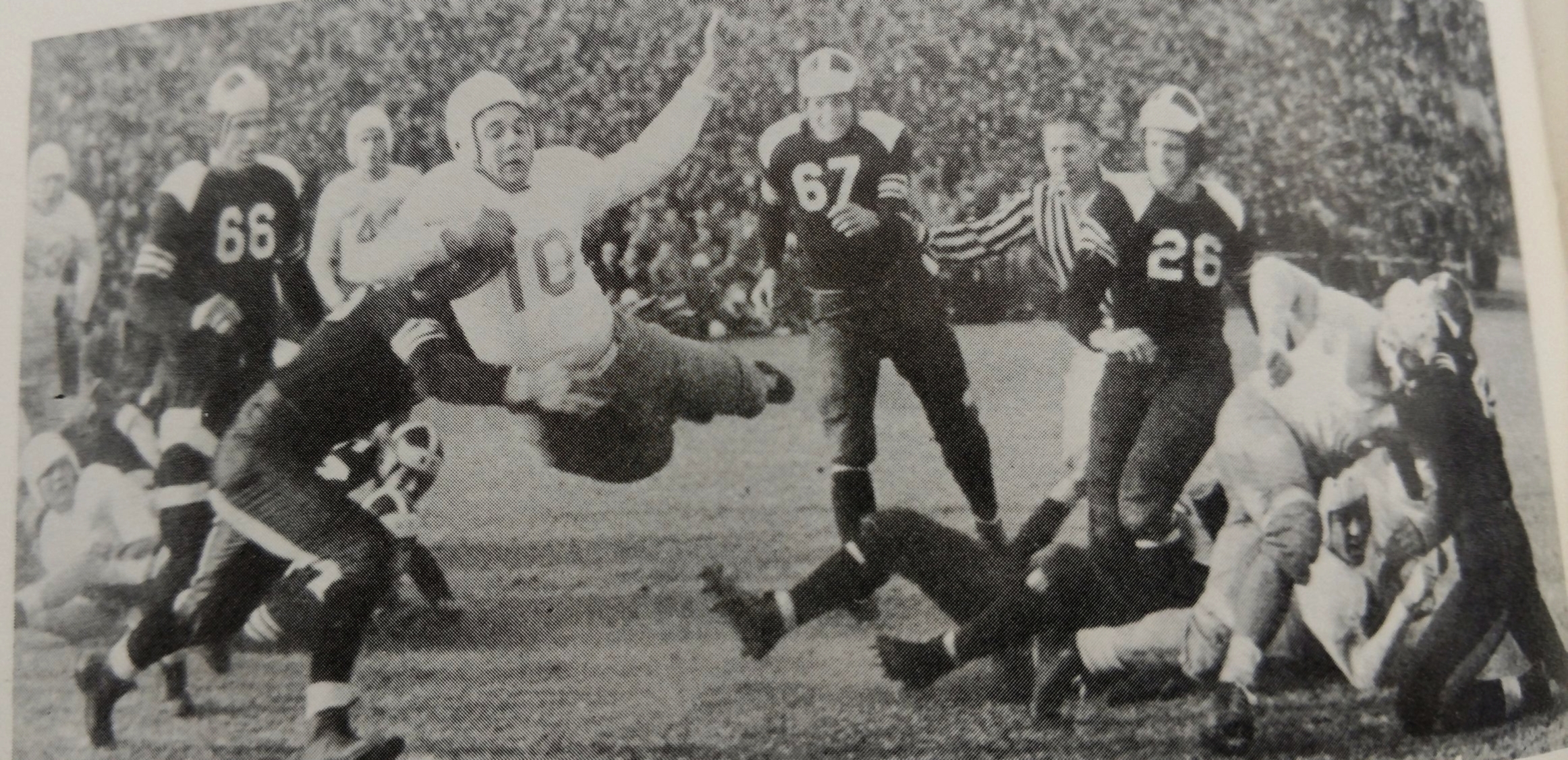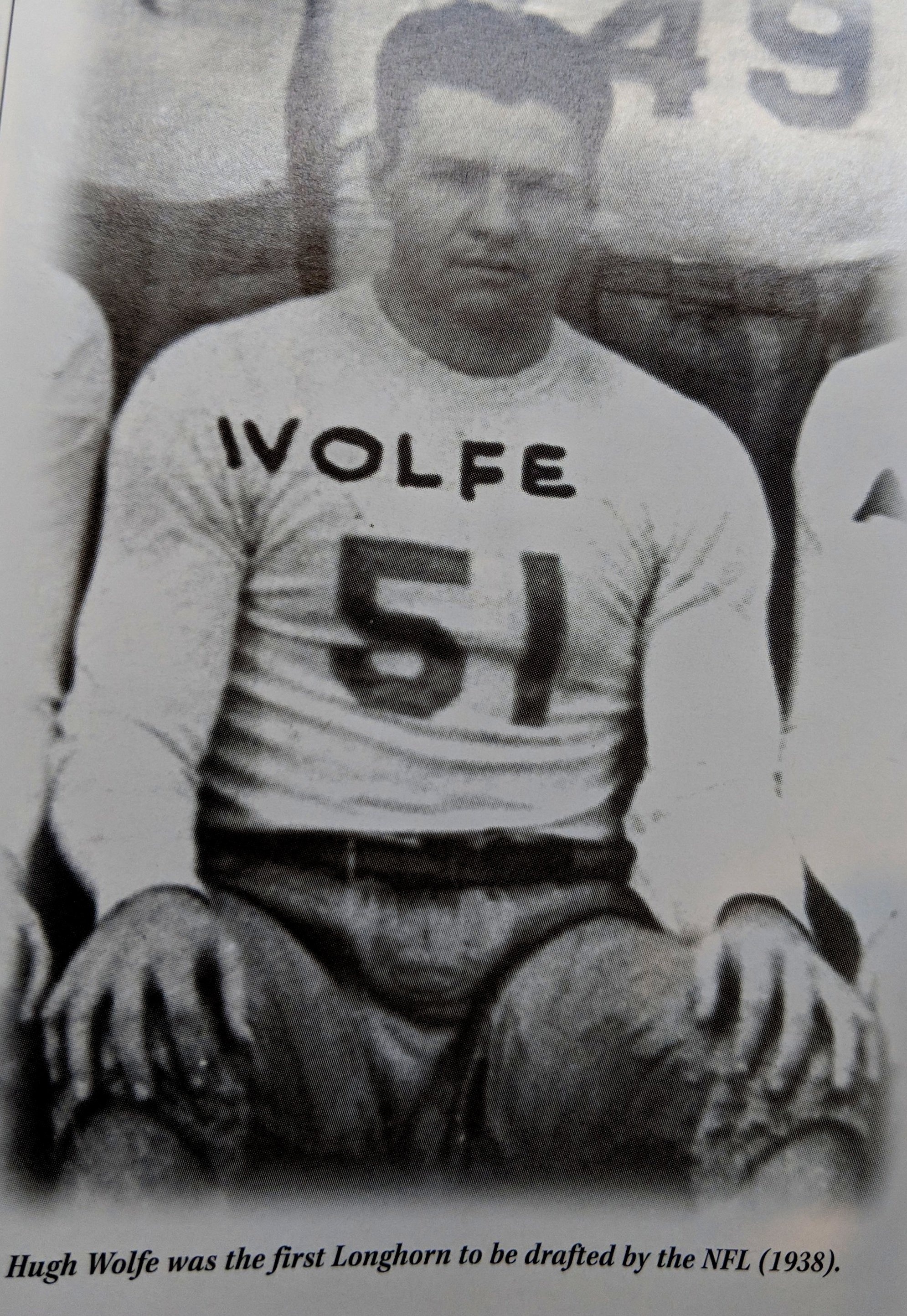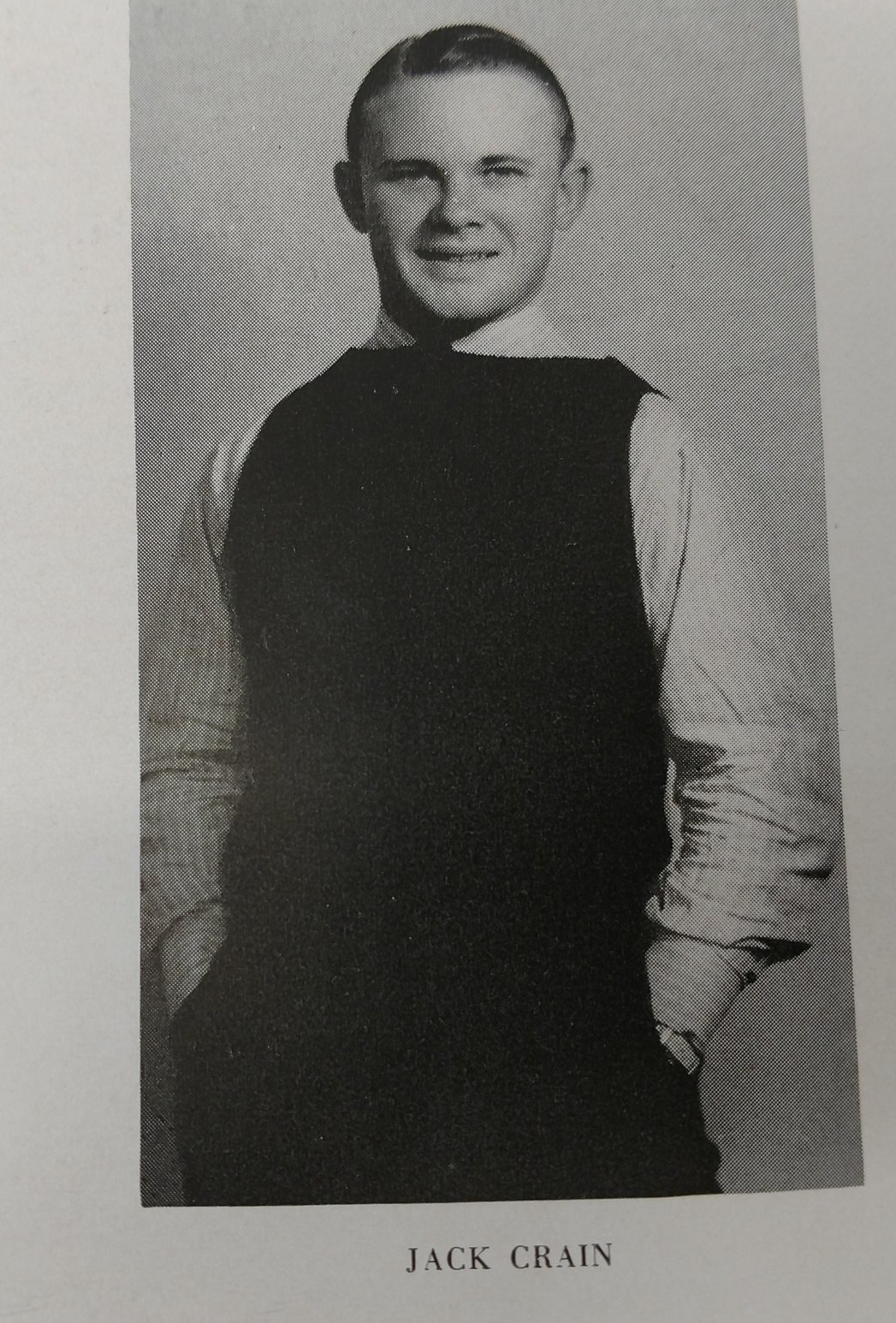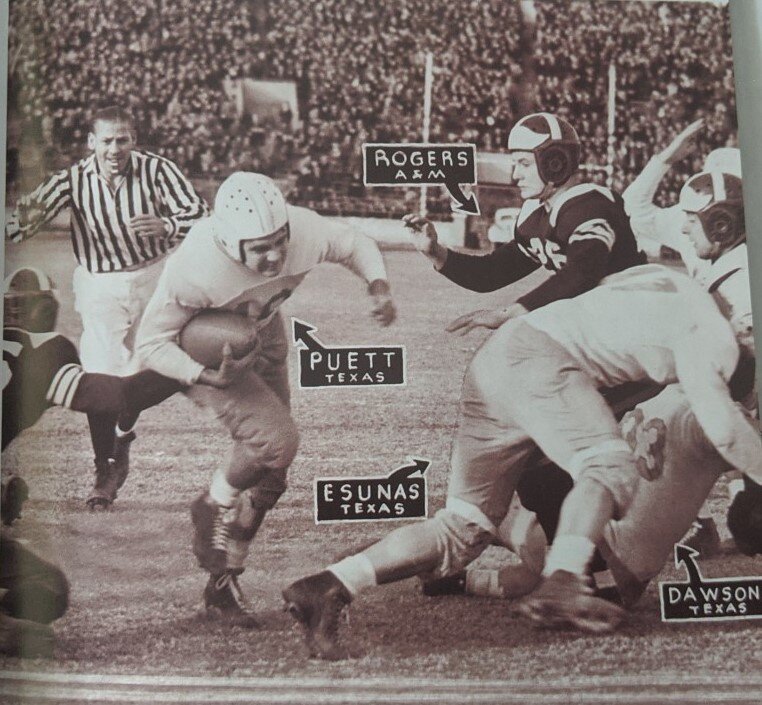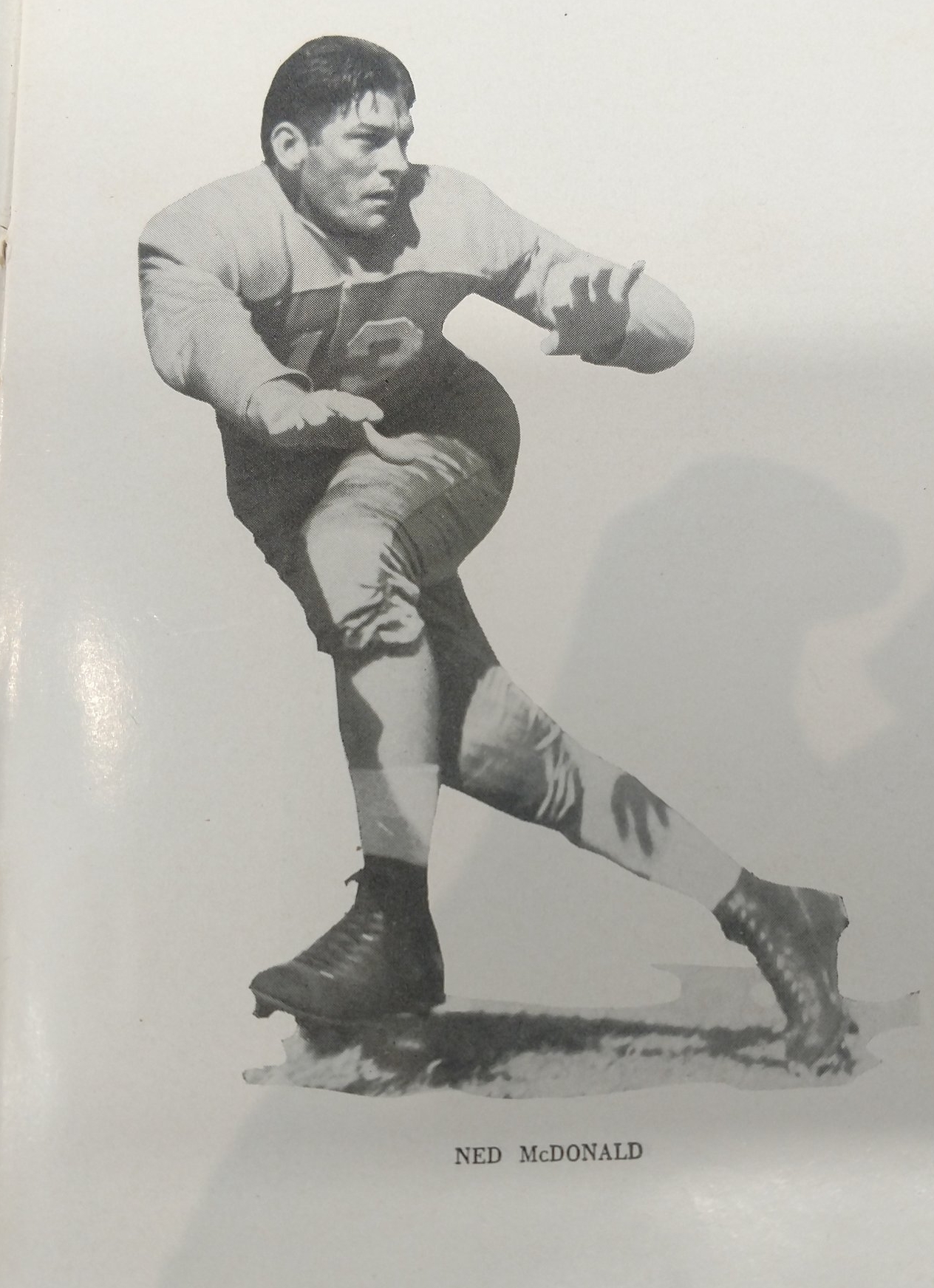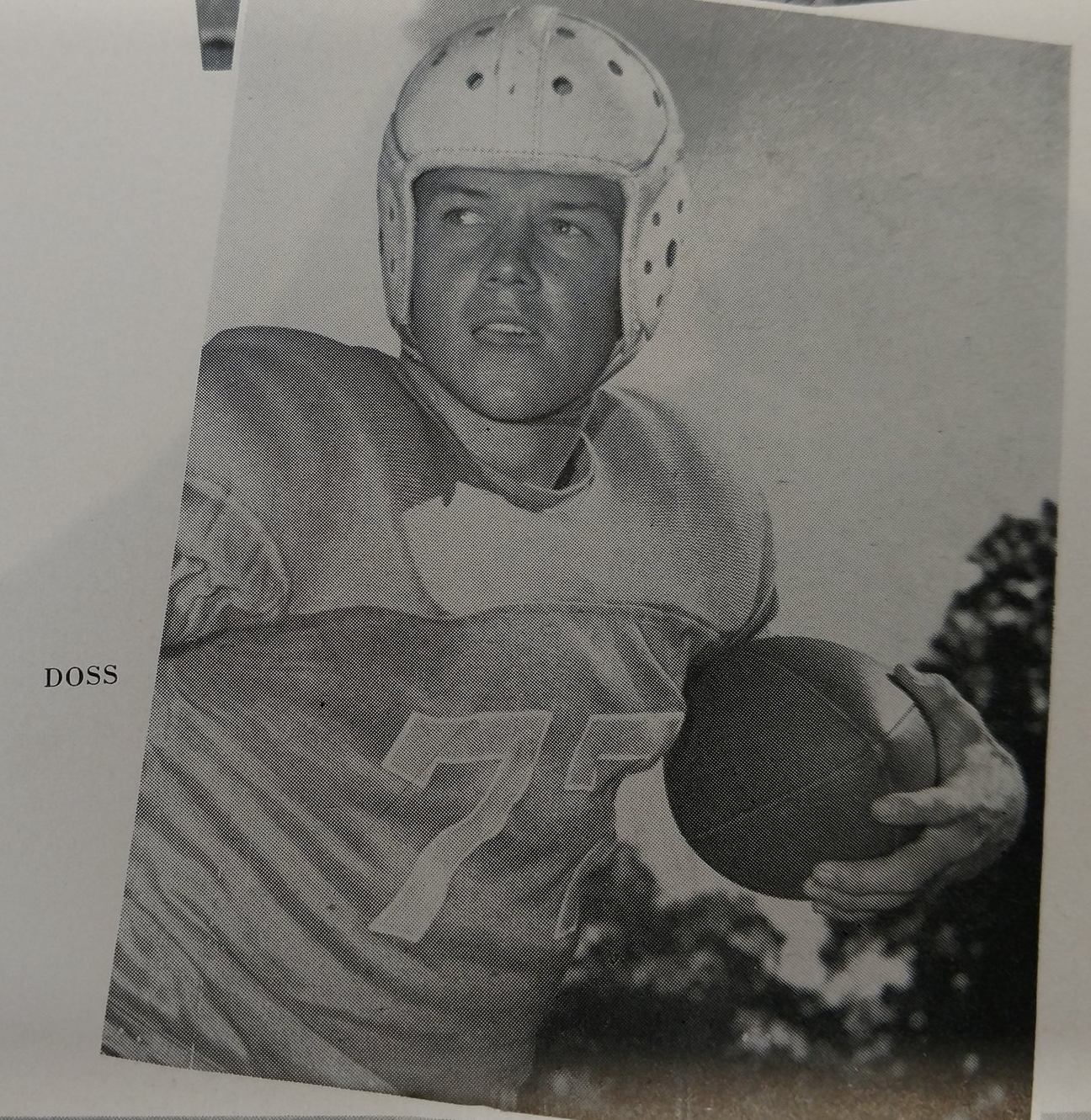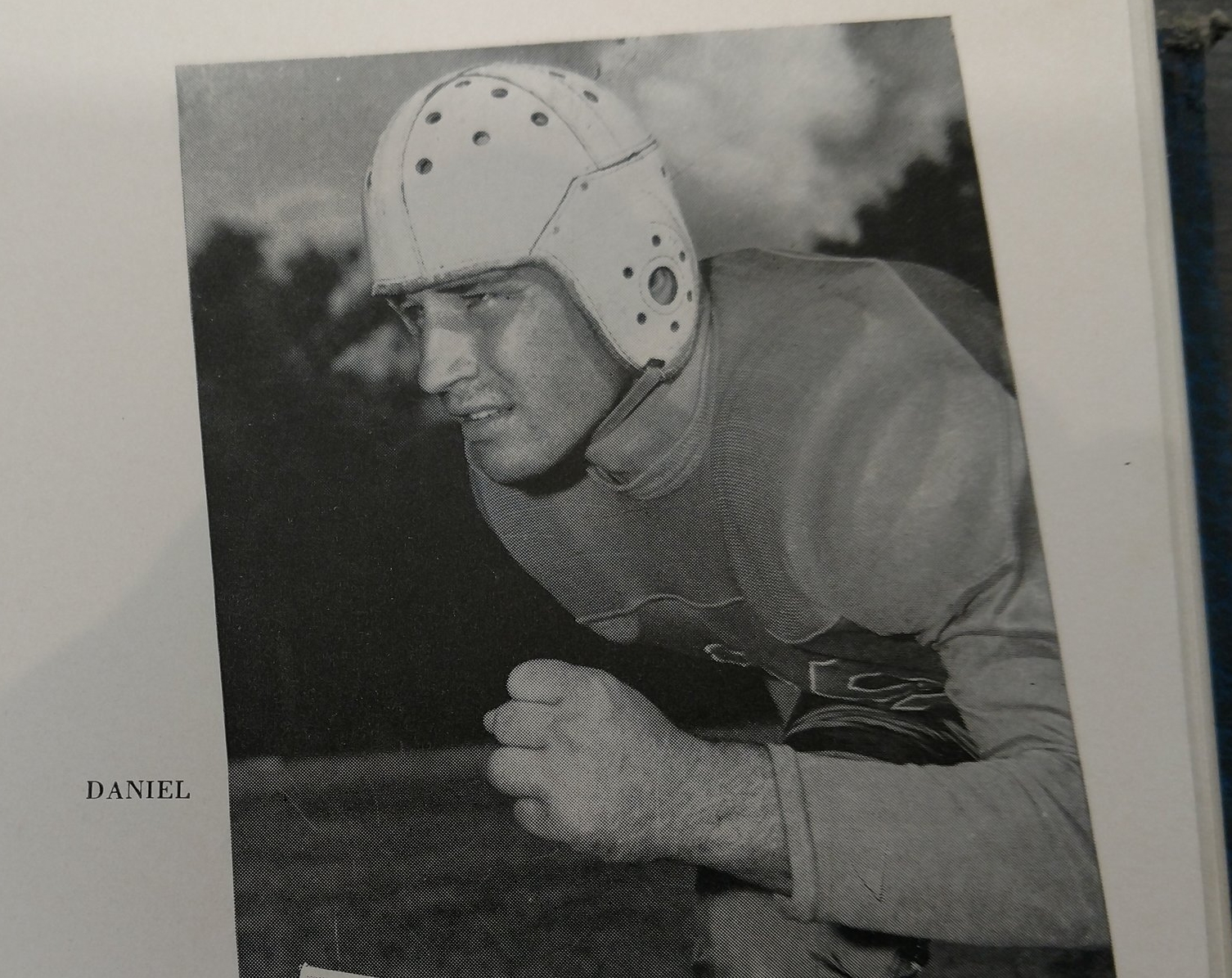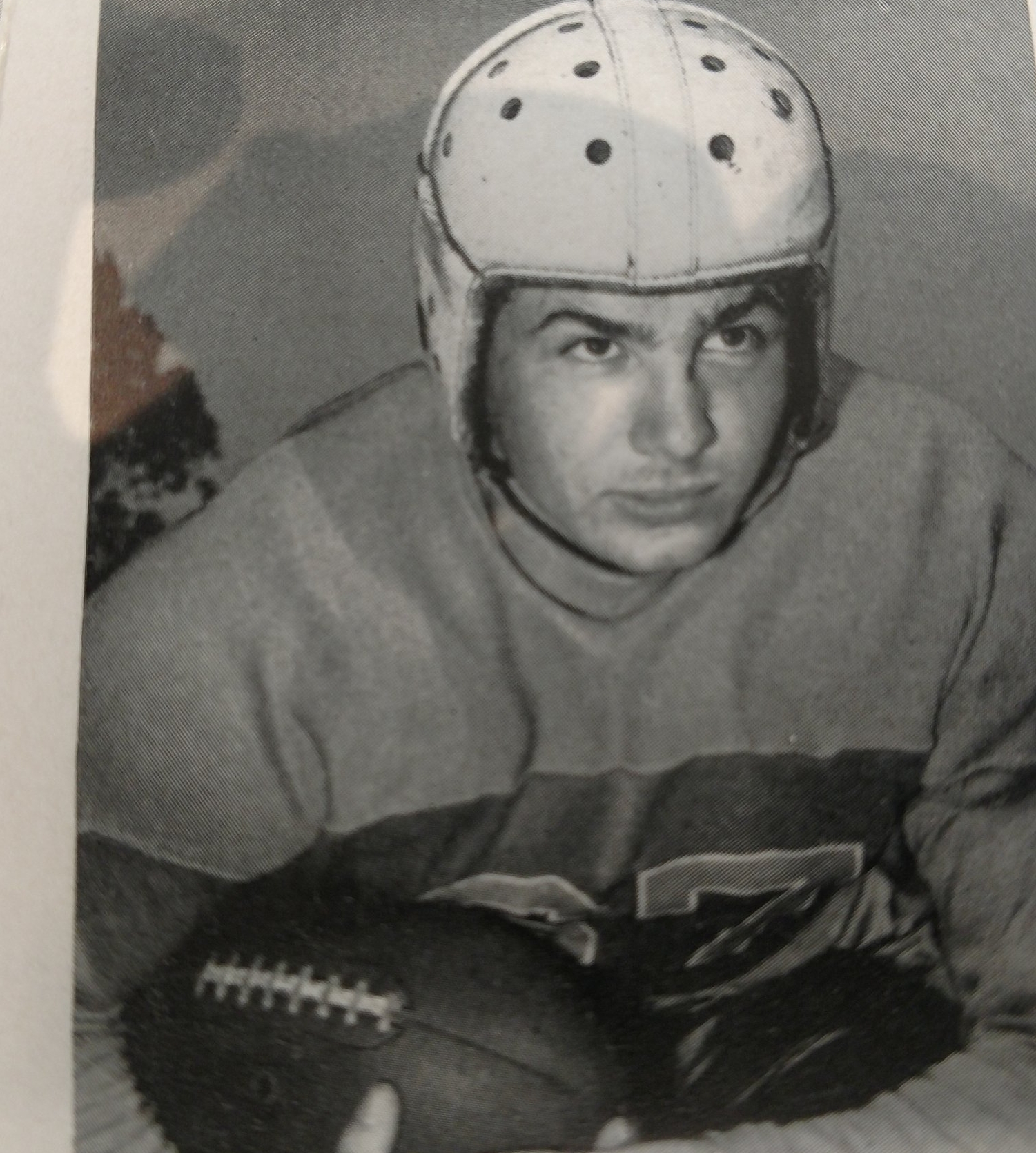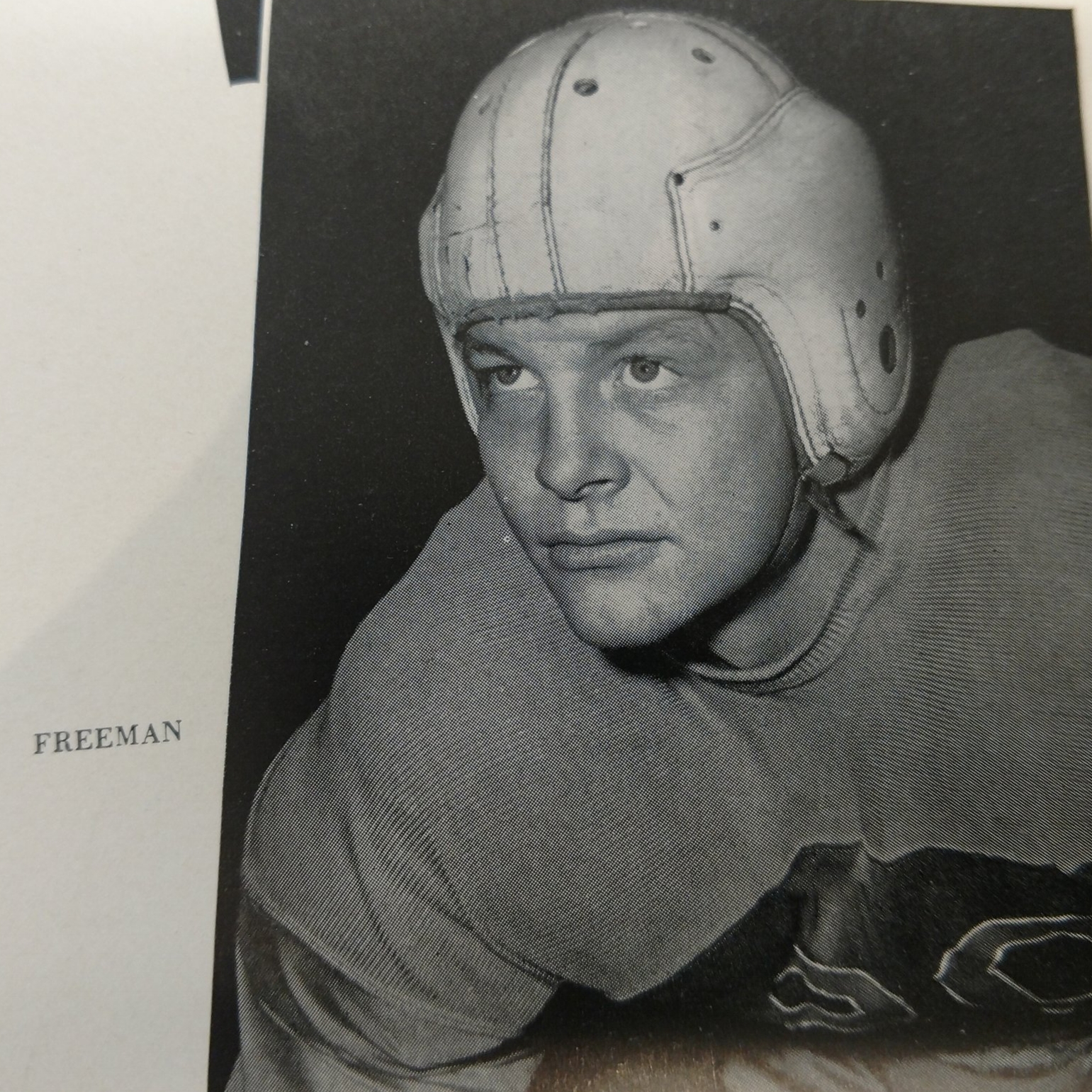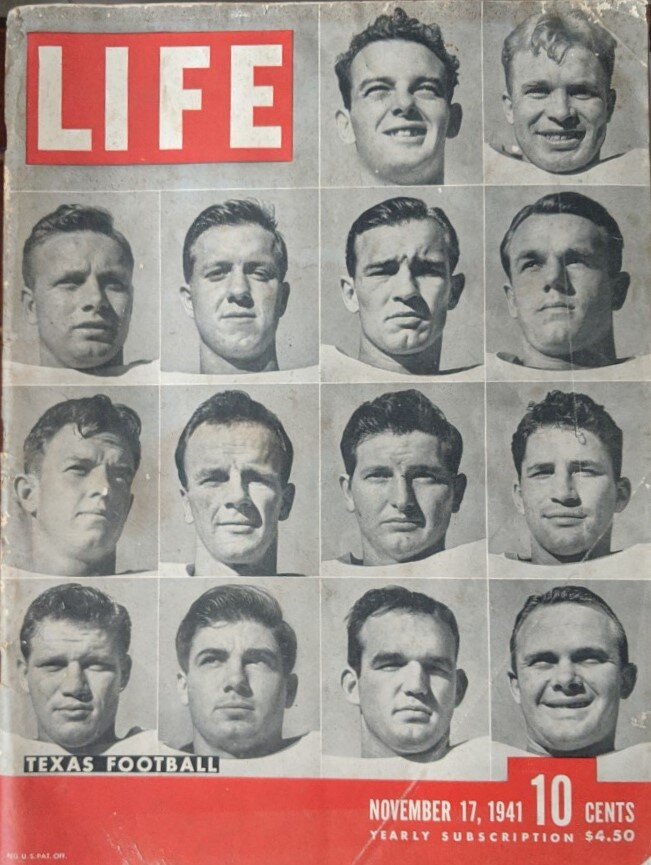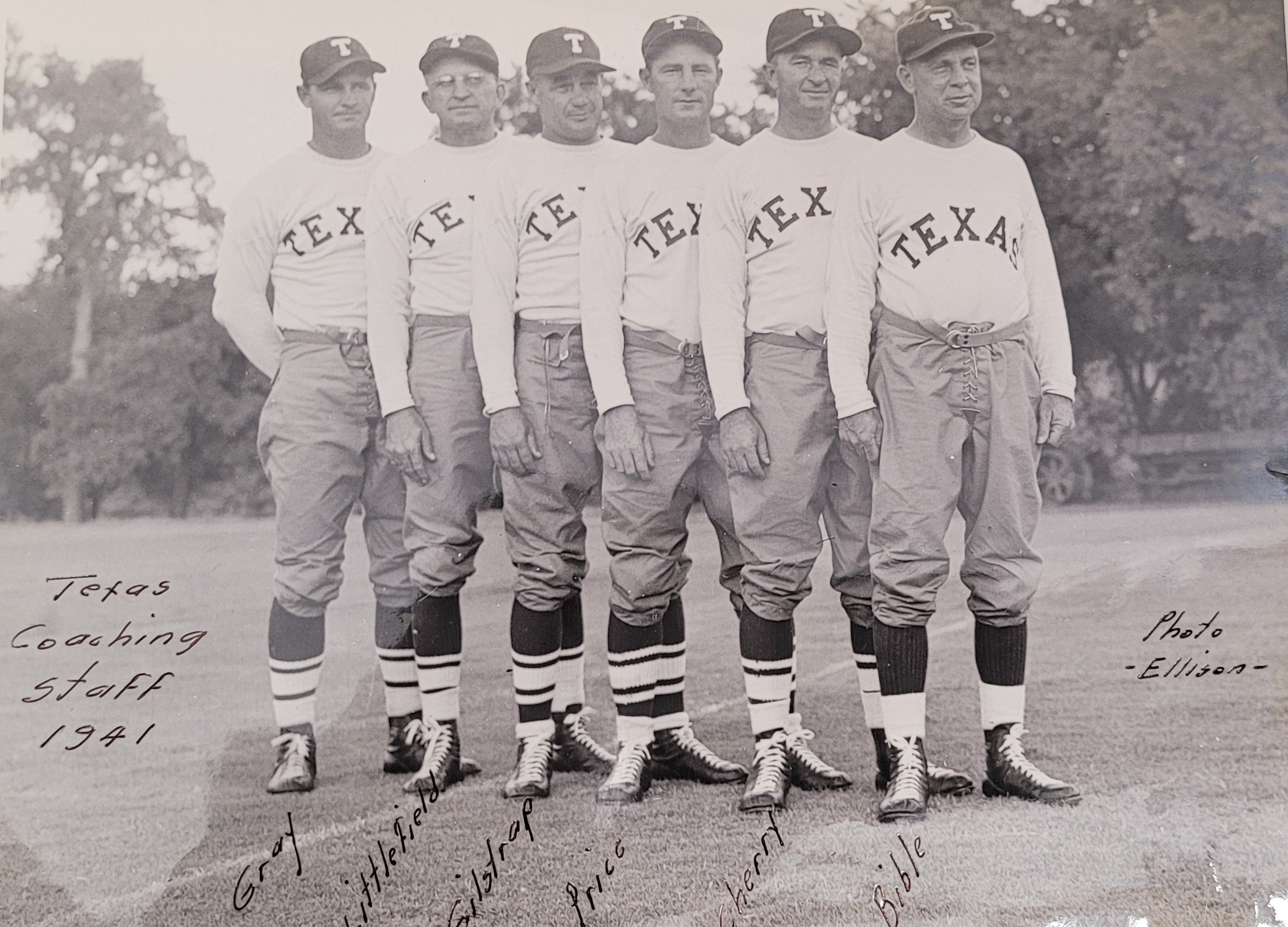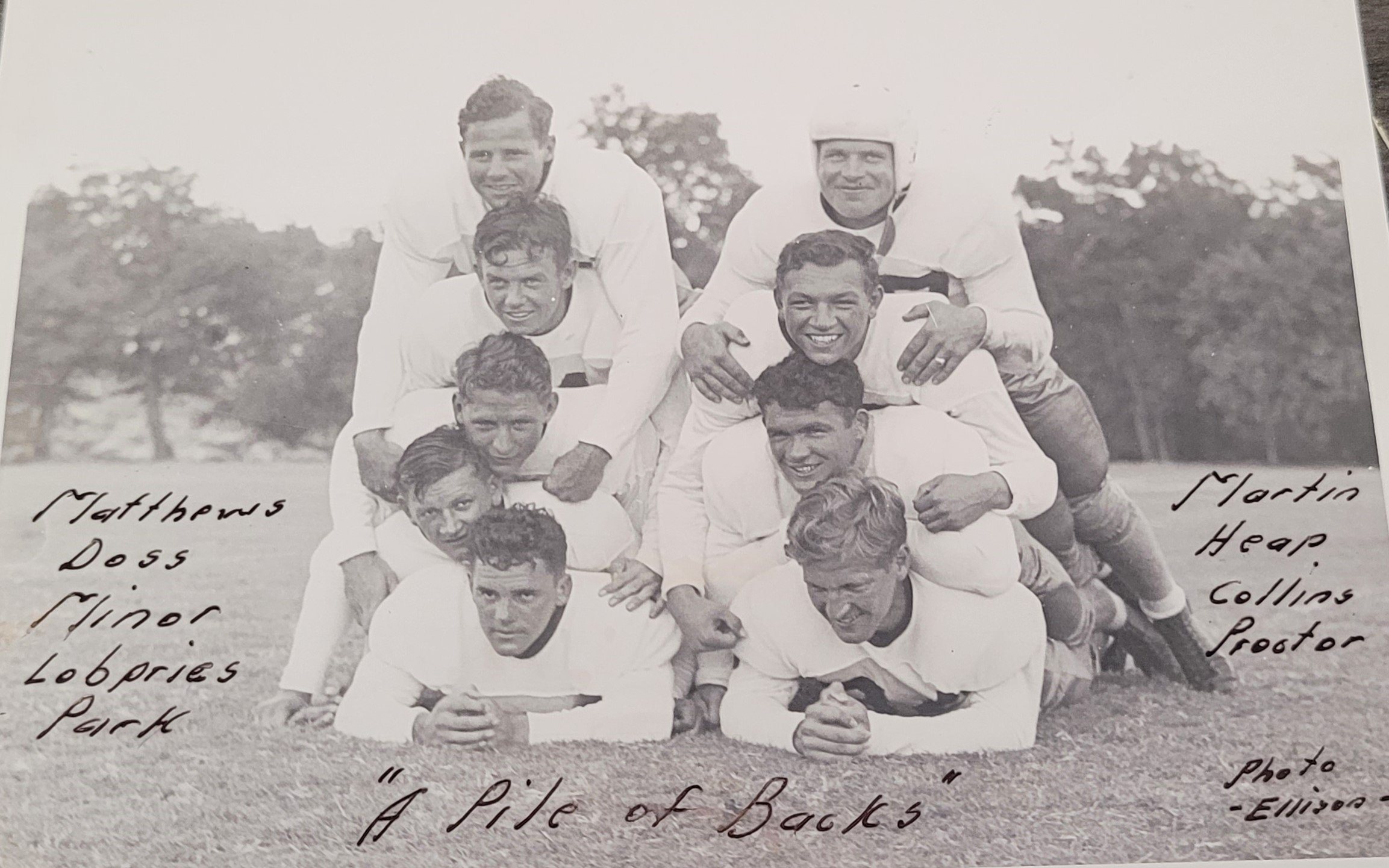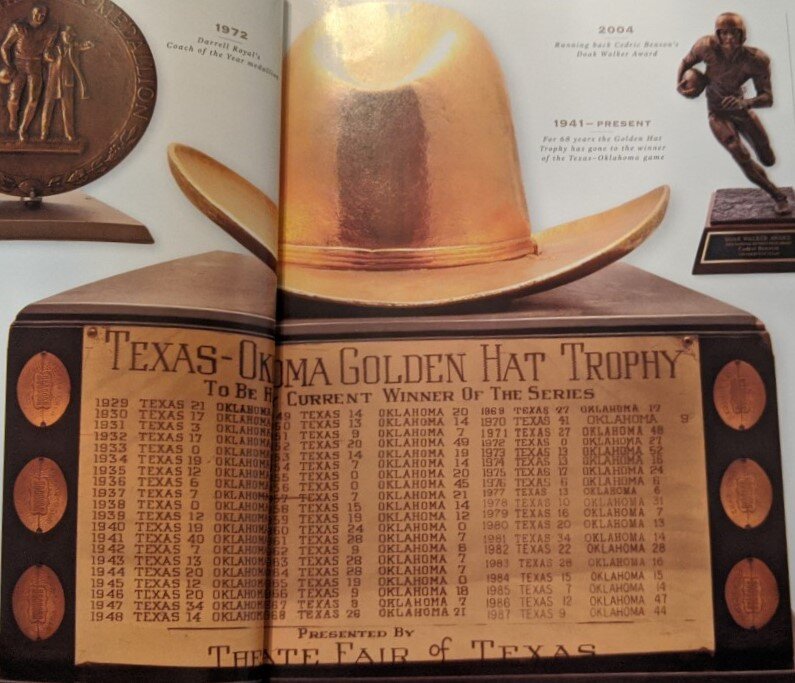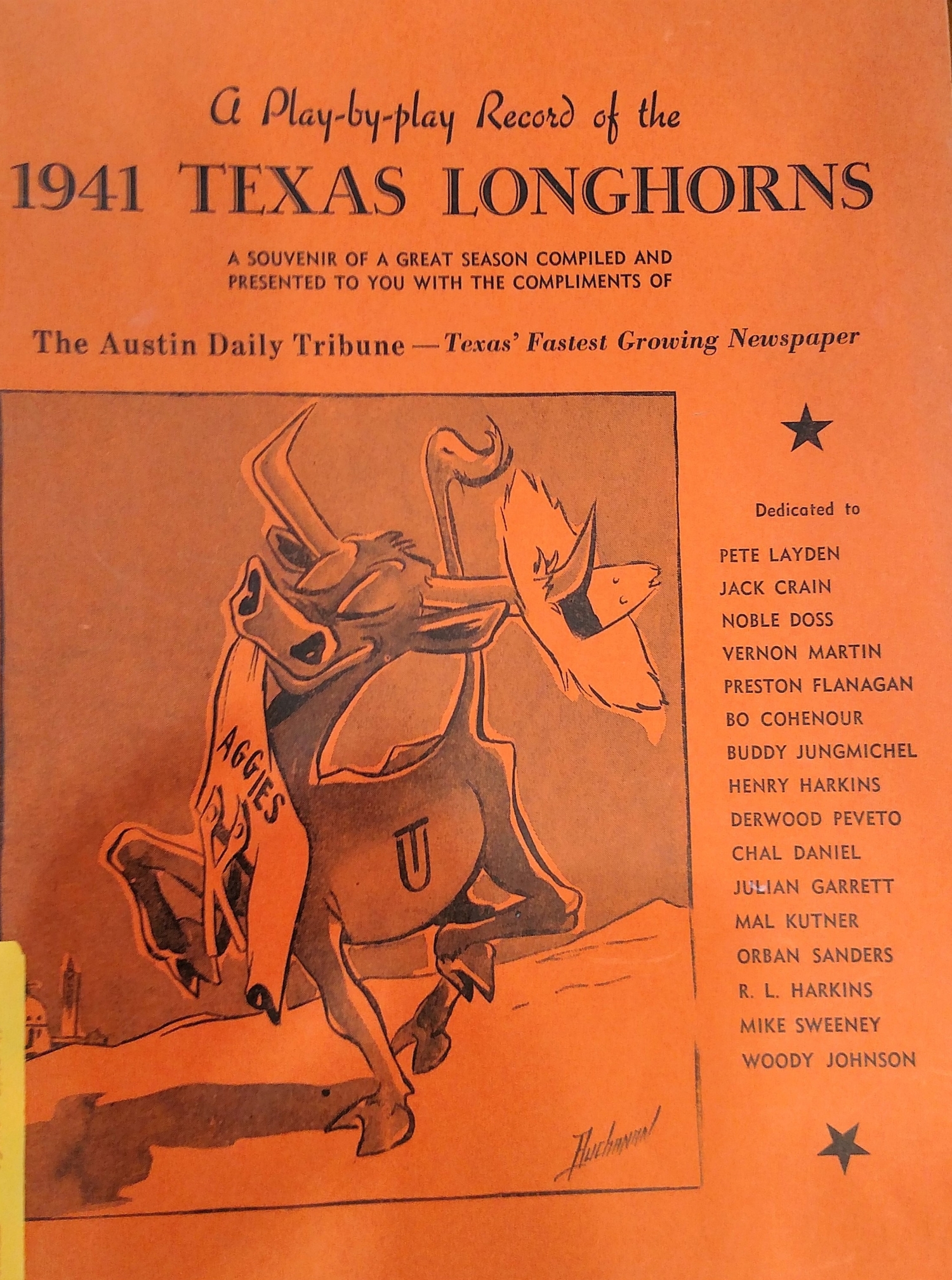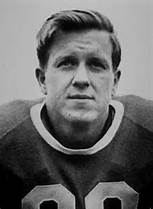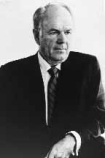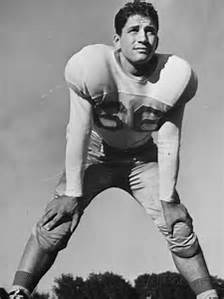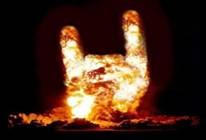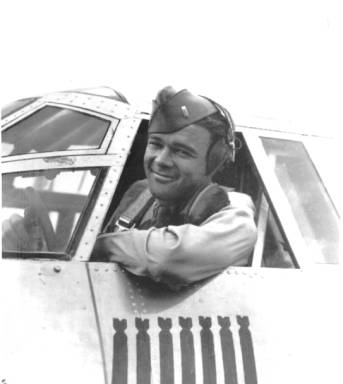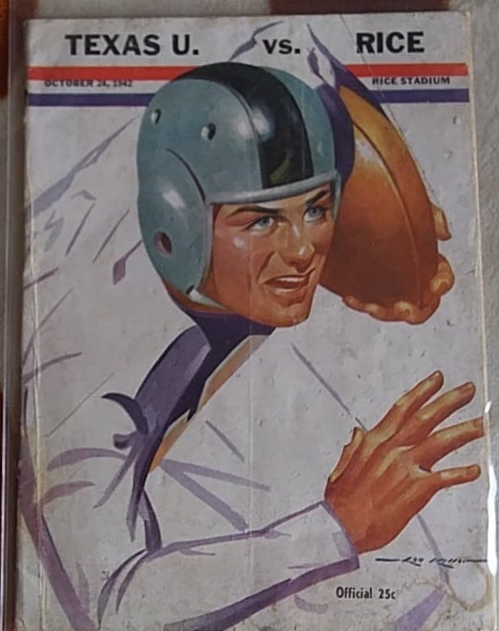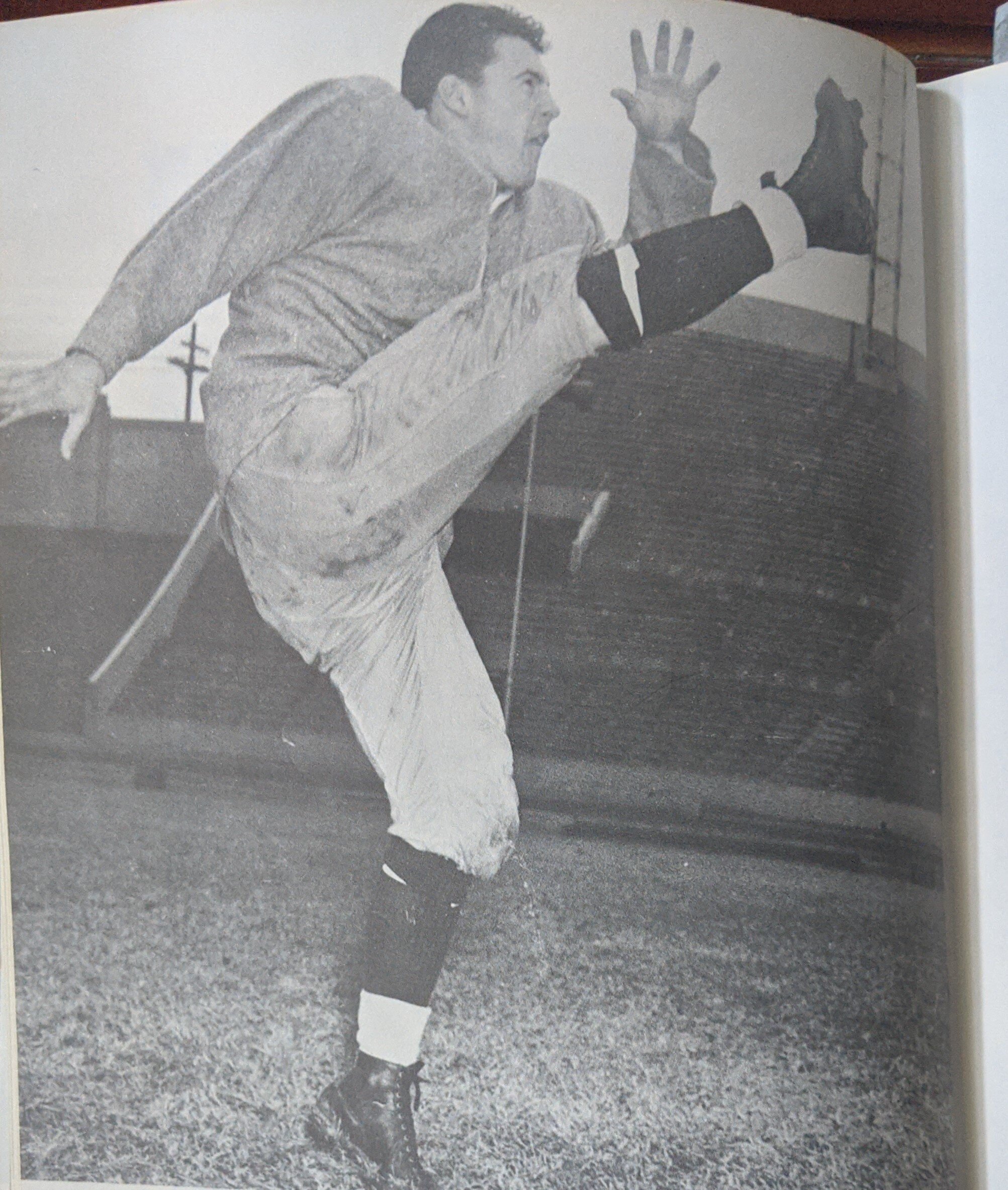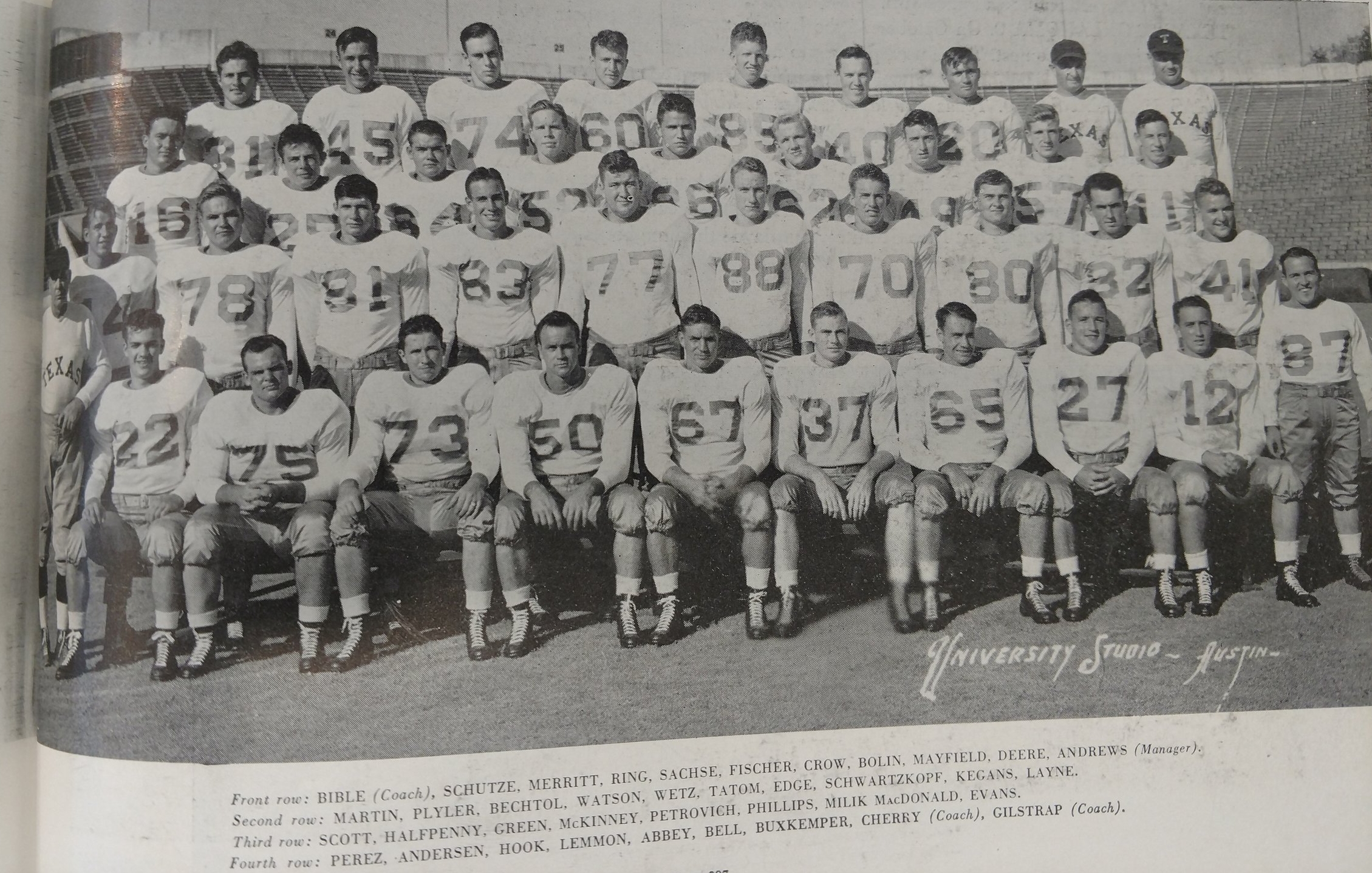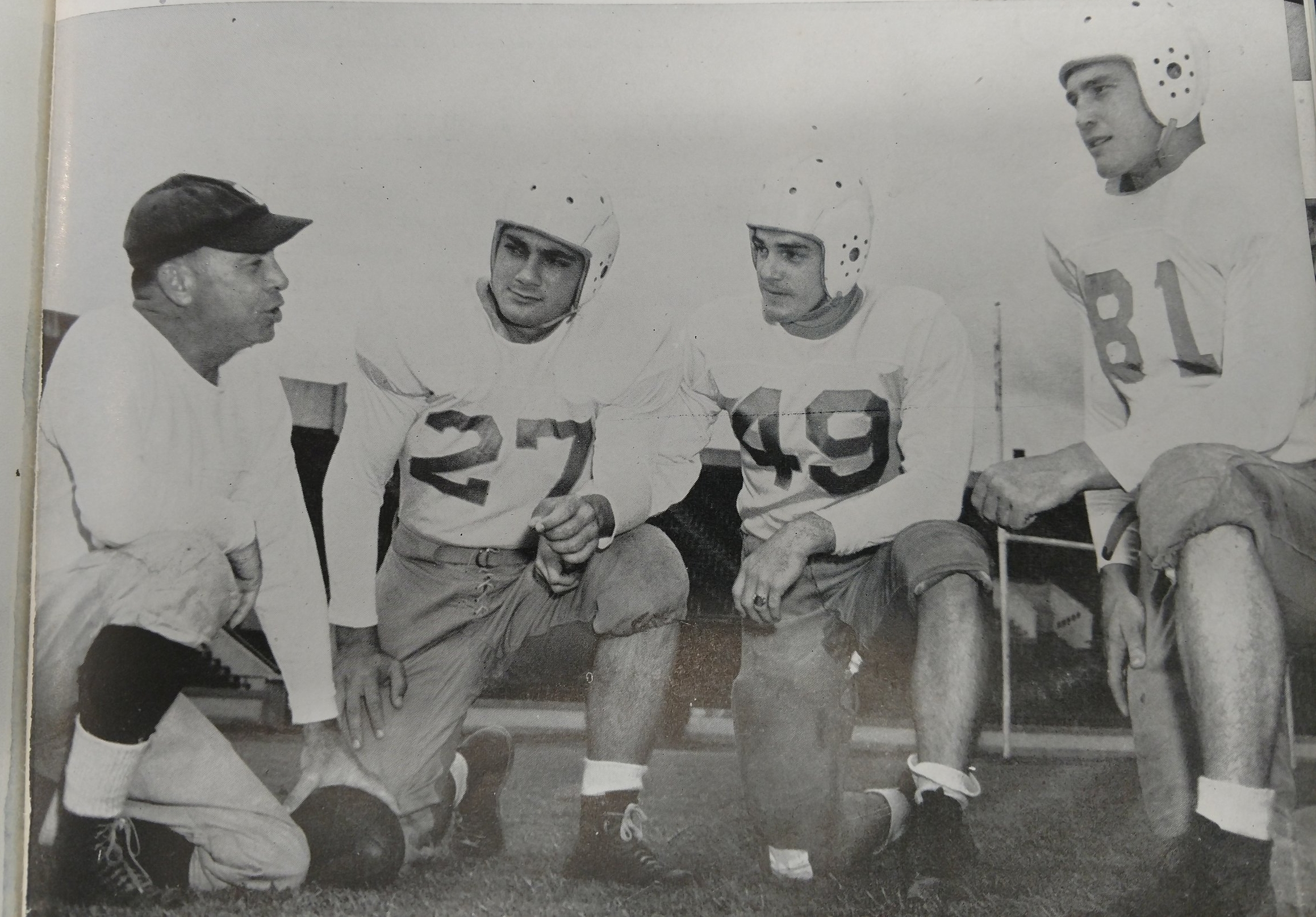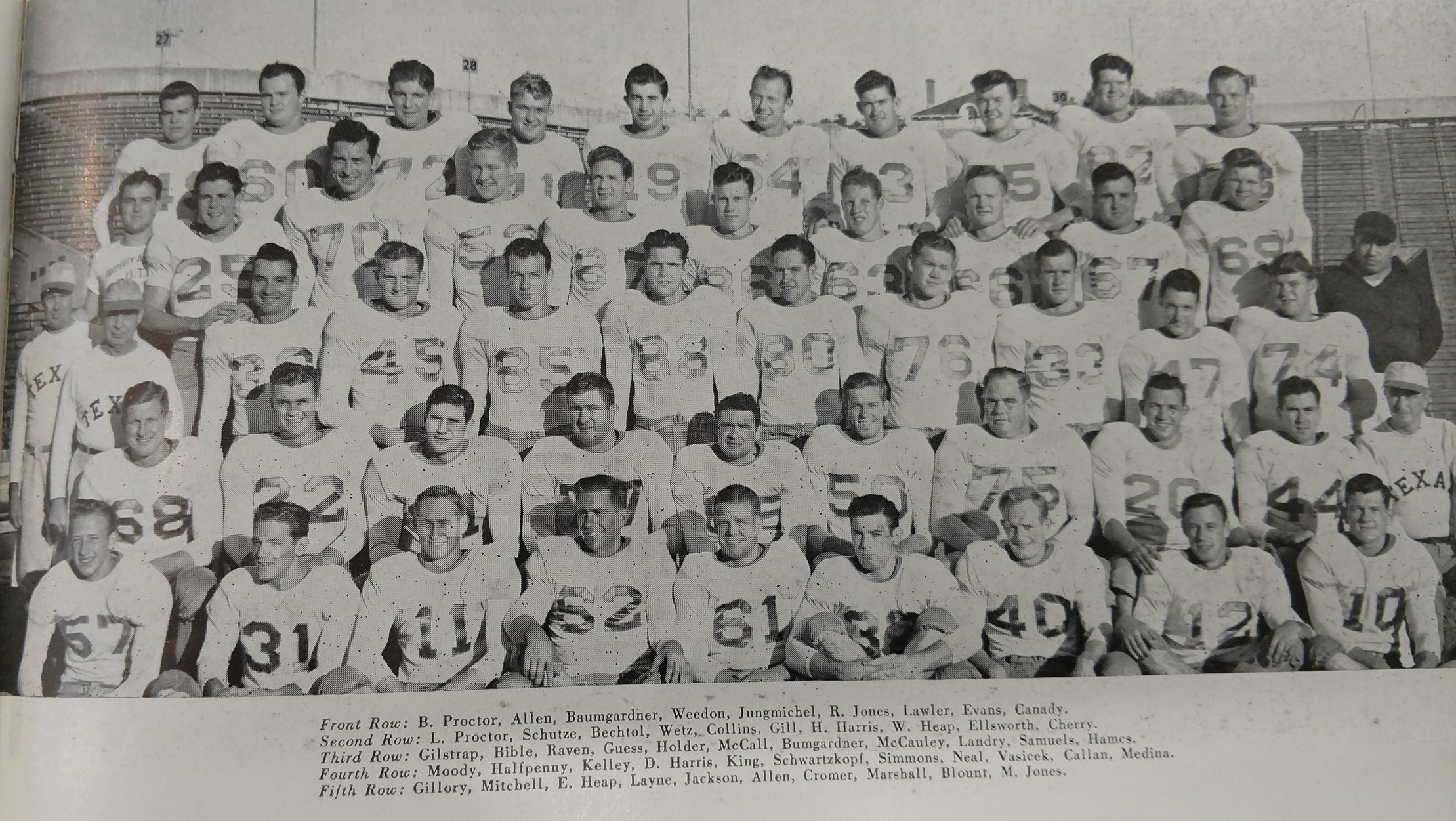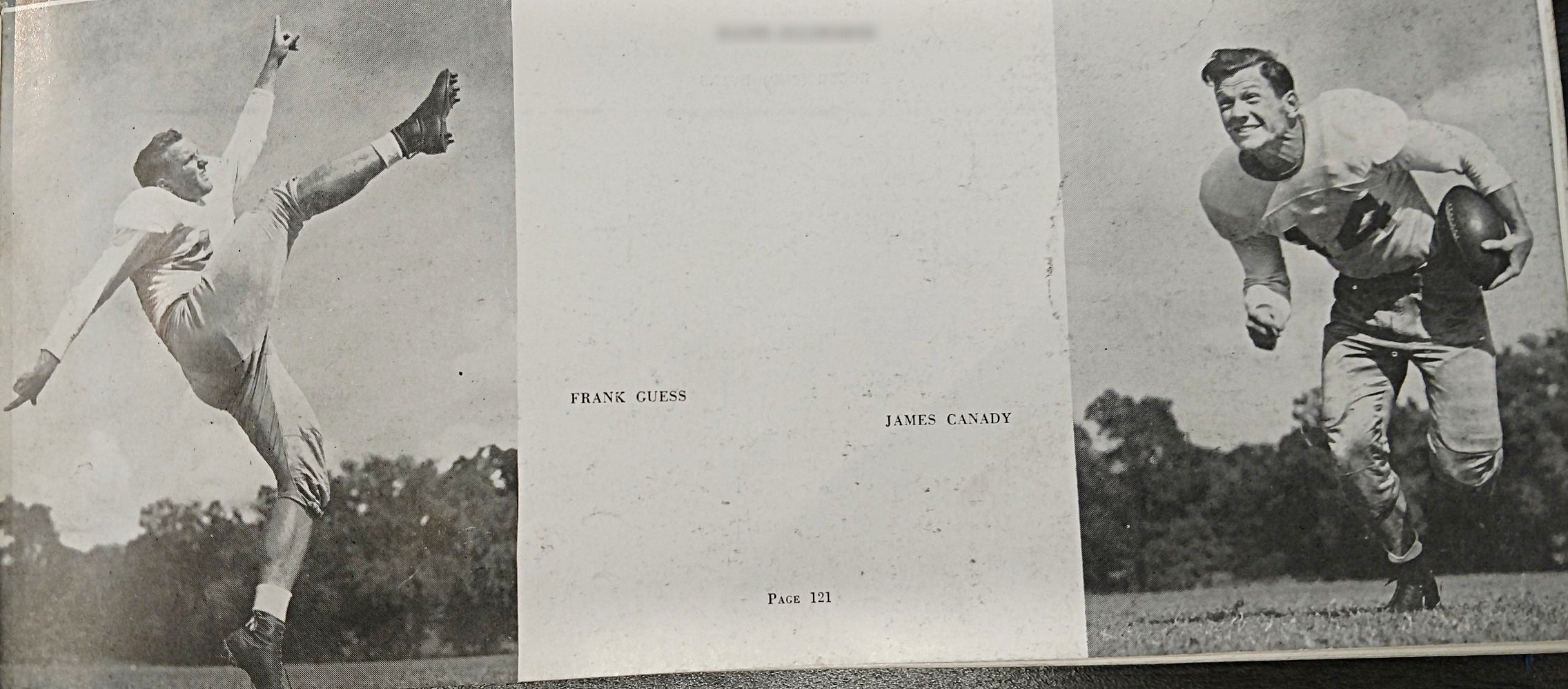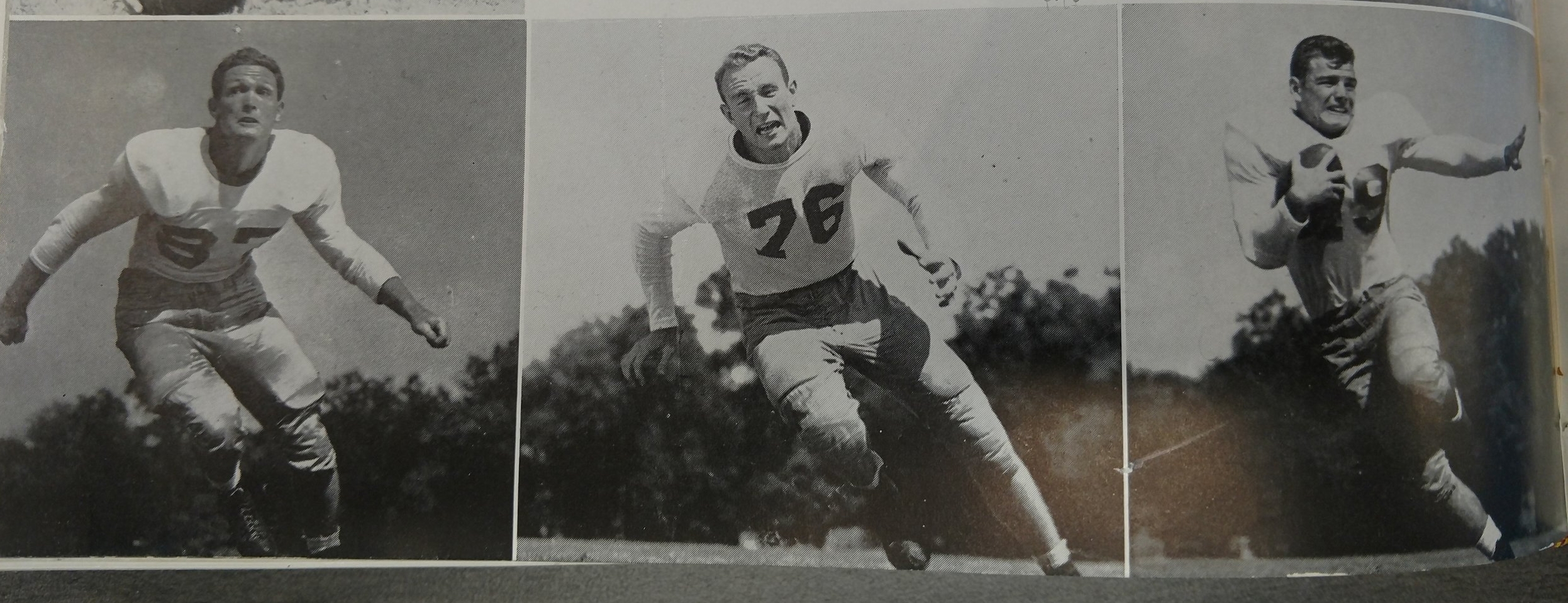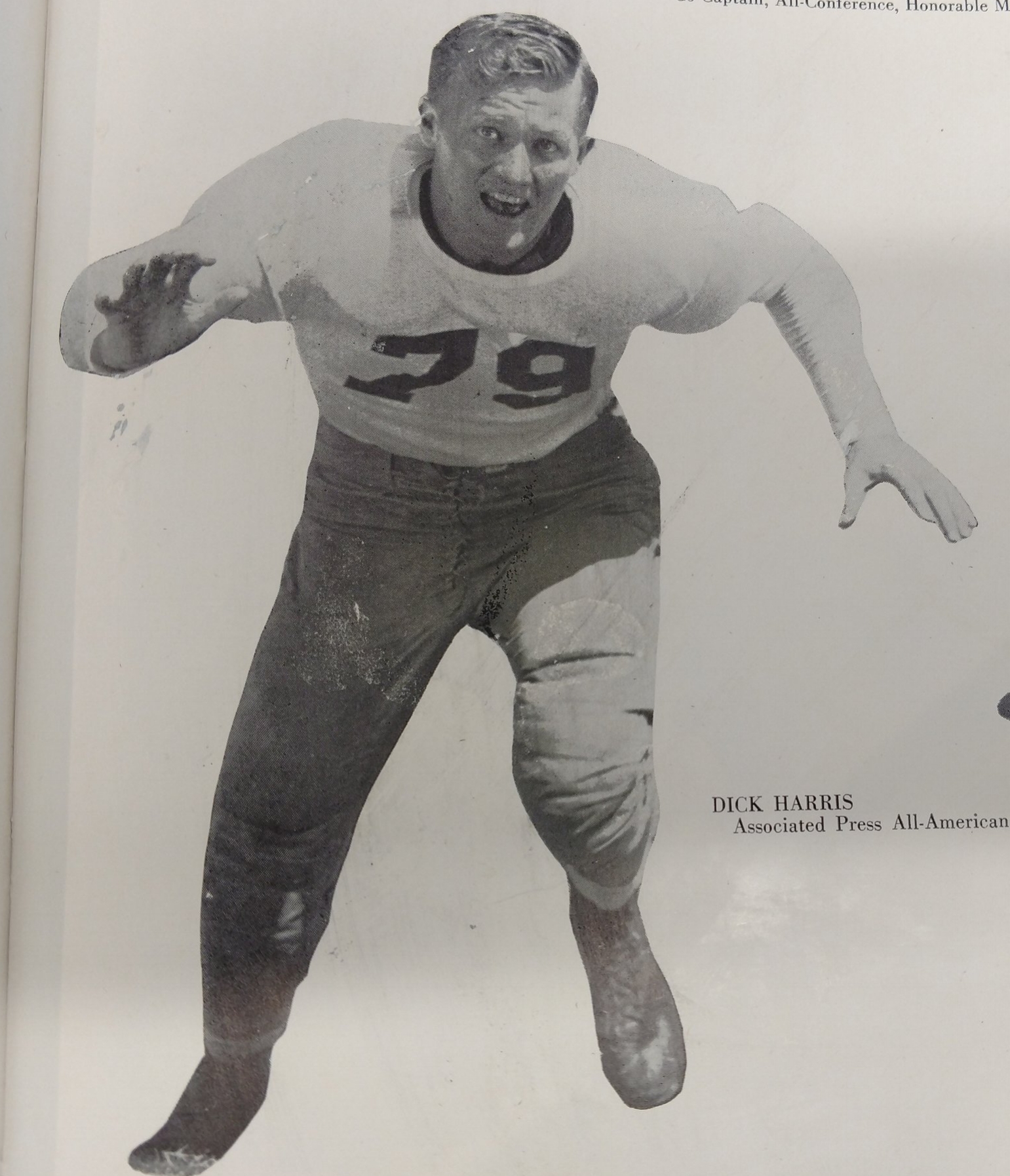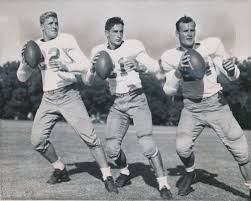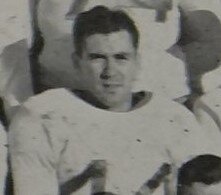From 1893- 1933 Texas football was consistently good, but by 1933 Texas football was ugly. Texas had its first losing season. In 1936 the Horns were bottom dwellers in the SWC. Texas needed a football guru to turn the program around from the Chevigny debacle and found one in former Aggie and Nebraska coach D.X. Bible. Chevigny was making $5000, the Texas administration offered Bible $15,000. Twice as much as the President of the University.
Coach D.X.Bible
A football Player Said Of Coach Bible "He's As Confident As A Banker, Astute As A Schoolmaster, Poised As A Preacher, And As Expressive As A Salesman."
In The Early Years Thru 1965, Rice, Arkansas, SMU, And TCU Played The Spoiler for Many Potentially Great Longhorn teams.
Coach Bible was meant to coach! He studied the sport under Z.G. Clevenger, Amos Alonzo Stagg, Pop Warner, Fielding Yost, Dr. Henry Williams, and Bob Zuppke.
Athletes were still not offered scholarships. SWC rules said athletes could be paid 50 cents an hour, up to $50.00 a month, for jobs around the campus. The SWC also allowed EXES to fund the job programs, offer summer jobs, and recruit athletes for visits to Texas.
The "Bible" Plan focused on building a relationship with the high school coaches. The state of Texas was divided into 15 districts, and alumni groups were actively recruited in each district.
Bible also standardized campus employment so that athletes could earn their school expenses within conference rules. Bible was also one of the first College coaches that changed the recruiting pitch from a pay-to-play incentive to convincing athletes to attend UT for its educational advantages.
By 1939 Bible had turned the football program around.
While he was the Athletic Director, his expertise was in football. His teams were known for winning games using building blocks constructed from executing successfully small details to win games. A day in Coach Bible's life during football season included:
A discussion with the publicity director;
personal recruiting of a boy who visited the campus ;
Planning the blocking assignments and formations for the next game;
watching the game film from the previous week and implementing corrections necessary to get better;
and finally running the plays at practice and again correcting mistakes to prepare for the next game.
He ended his coaching career at Texas with 63 wins, 31 losses, 3 ties, and three conference titles. He continued as an A.D. for 10 more years and was instrumental in hiring Coach Royal.
However, Bible never delivered a National Championship to Texas.
A condensed bullet point history of Texas football from 1937-1956 follows. Please go to the "credit" section of this website to view books you can purchase from many fine book stores about Texas football history, or please visit the official University of Texas Longhorn site Texassports.com.
Since Texas had no athletic director, Dolley offered Bible $7500 for coaching football and another $7500 for assuming the athletic directorship and an unheard-of 10-year contract for his services. Some Houston exes contributed $5000 to cover Bibles’s losses in selling his Lincoln house. The administration also agreed to Bible’s request to hire the most outstanding high school coach in Texas - Blair Cherry and the best junior college coach - Bully Gilstrap. Coach Bible’s contract was twice as much as the President of U.T. and 4 times the salary of the governor of Texas. The Saturday Evening Post magazine found humor in Dr. Dolley’s and Regent Starks's offer to Bible and wrote an article titled “The Bible and His Angel.”
The honeymoon between Stark and Bible was short. When coach Bible told Regent Stark he could not sit on the bench with the players offering coaching guidance during the game, all hell broke loose. Stark was so angry he no longer offered favors for the players, to pay for some team functions out of his pocket, quit buying uniforms for the band, and stopped buying rare books for the U.T. library. Finally, in a fit of spite, he sent his sons to Texas A & M.
In the book “The Texas Longhorns”, the author Mark Stewart says, “The Texas football team spent 40 years searching for the perfect coach. The school found him in 1937. Dana X. Bible had one of the best football minds in the Country. “
A story of Texas Football (Hook’em Horns by Denne H Freeman says, “The Longhorns came after Bible hard in 1937.” The school had not captured a championship since 1930.
1937- 2-6-1 - COACH BIBLE is hired and The Cotton Bowl is formed.
Longhorn Hall of Honor inductee Hugh Wolfe was the Longhorns’ first NFL draft pick. At Texas, he was the SWC champion in the discuss and the leading scorer for the football team.
Not only is The Country In a depression, but so is UT Football.
Bible inherited a mess left by poor recruiting decisions during Chevigny’s years. The best kids in Texas wanted to play for SMU, Baylor, and TCU. Sammy Baugh wanted to be a Longhorn, but needed assurance he could play baseball and football just like James Street did 31 years later, but Chevigny said no, and Sammy went to TCU, and we know how that worked out for the Horned frogs.
In a terrible year for Longhorn football, there was one ray of light. Football fans thought that Baylor would be invited to the Rose Bowl. Baylor was unbeaten when they played Texas but lost the game to the Horns 🤘 . One of only two victories for the Horns in 1937.
Before joining the Longhorns, Dana Bible had a successful coaching career with The Aggies and the Cornhuskers. The U.T. Administration Bible, a 10-year contract at $15,000 a year, and UT paid his Income Taxes. This was an outrageous salary at the time, equating to $245,000 in 2013 dollars. During this period, a professor's salary was less than $4000, and the UT President Made $8000.
However, with the hiring of Coach Bible, Texas football entered one of its finest eras. Coach Bible executed "The Bible Plan" To turn Texas Football around. He pushed the players to succeed In football, the classroom, and life.
Author R.E. Blount said that “Mr. Bible was a sentimentalist who remembered worthy feats and great plays of the past by other Longhorns that had won games or worked consistently for good yardage. “ Bibles pep talks usually contained elements of the teams’ responsibility not to embarrass their family, Longhorn fans, or the state of Texas with poor play.
Coach Bible in 1951 was inducted into the National Football Foundation’s Hall of Fame. In 1960 he was enshrined into Texas, Texas A & M, and Nebraska Hall of Honor.
SWC passed a rule that disallowed a schools’ game films for newspaper reproduction because it could cast a bad reflection on the officials.
Coach Bible
The Tower's construction was Completed in 1937. Laughingly, Texas writer J. Frank Dobie called it the last erection of an impotent administration with a Greek temple on top.
This is the first year that victory lights are used on the newly built tower.
UT was still considered a “feeder” school, losing professors who could move up to the better schools and keeping those who could not.
1938- 1-8
An Awful Year For "Ali Bible And The 40 Sieves" - Horns lose their first season-opening game in the History of Longhorn Sports.
Wally Lawson holds the record for the most punts in a season (67) in the first 100 years of Texas football.
But the freshman team is great and actually beats the varsity in a scrimmage. Bible, with this great recruiting class, sets the stage for the turnaround that started in 1939.
125 freshmen tried out. Money was the primary motivator for young athletes. A scholarship meant $2.50 a month with tuition and room and board paid.
Noble Doss says that after the freshman beat the varsity, a team spokesperson visited Coach Bible and told him the team members needed more money. Bible agreed but stipulated that the boys would have to meet with him one-on-one. Not a single player visited Coach Bible.
Poor Aggies—the Memorial Stadium jinx continued. The Aggies had still not won a game in Memorial Stadium. Texas picked off 6 Aggie passes to salvage the only victory in 1938.
However, even in the midst of losing, one guy came shining through. He was a "jack-of-all-trades player" named Hugh Wolfe, who earned All-Southwest Conference honors as a running back.
In the 1938 draft, the Pittsburgh Steelers took Wolfe in the second round. He played only one season—in 1938 with the New York Giants. He was the first UT player drafted in a system that began in 1936.
1939- 5-4 WWII STARTS -- this year is a turning point in UT football.
front row Flanagan, Basey, Crain, Daniel, Grubbs, Dawson, Jackson, Williams, Gill, 2nd row- Bibble, jung michael, Sanders Garrett, Cohenour, Mauldin, Martin, Goodwin- 3rd row M.W. Kelley trainer, Pool manager, R.L. Harkins , Doss, Scott, Hawthorne, Thayer, Kutner, Layden, Park, Gilstrap.
Helmets were required starting in 1939.
Bible directed the building of a new film and lecture room, a dressing room for the visiting teams, a new press box for Memorial Stadium, and a renovation of the old freshman dorm. The biggest project was building Hill Hall, a four-story, $125,000 dormitory to house athletes of all sports. The building was dedicated to Dr. Homer Hill The Team Physician from 1893-1923. It was renamed Moore-Hill Hall after some new wings were added.
When the Horns played Wisconsin in 1939, Coach Bible said to the team:
““Boys, your old friends are listening on the radio. Boys, don’t forget your mother’s, dad’s, your sweethearts, and family. Boys, this is a glorious day in Texas! Every man, woman, and child in the State of Texas has planned their day - every businessman has finished the job…., every professional man has closed his office- all household chores have been finished, all errands run. Boys, the Eyes of Texas are upon you this afternoon”. ”
Texas won 17-7
This Team holds the Longhorn Record For most safeties in a year (4), the fewest number of penalties on offense for a year (36), and the fewest returns allowed on a kickoff for the season (19).
Jack Crain (Cowboy Jack, Jack Rabbit or Nocona Nugget) is the first Longhorn to make the top 10 Heisman list.
Many Longhorn sports historians believe that the 1939 win over Arkansas 14-13 is just as important as the 1969 win over Arkansas 15-14. Bill Sansing, future head of Sports Information for Coach Bible was a student at Texas in 1939. He says, “There was a loser mentality. We were losing again, 13-7, with a minute to play. No one could have expected what was about to happen.”
Jack Crain's unlikely touchdown against Arkansas in the game's final moments changes Texas's mindset from negative to positive. This game is still referred to as the "Renaissance Game" because it provides positive momentum for the next 10 years. Coach Bible says Jack’s play is the “minute I’d like to best live over,”
Texas 14, Arkansas 13
October 21, 1939
Memorial Stadium (Austin, Texas)
Texas is behind 13-7 with just 30 seconds remaining in the game, and many fans are exiting the game. Quarterback Johnny Gill sees a weakness in the Arkansas defense and asks Jack Crain to trade places with him so that Crain can drift out to the flat for a screen Pass. UT fullback R.B. Patrick throws a short pass to Jack Crain, and Crain rambles 67 yards for a touchdown. The fans poured onto the field, and after a few moments, the field is cleared, and Jack Crain kicks the extra point to cement the victory. This win helps invigorate the Texas program.
Jack Crain “ The Nacona Nugget'“
Jack was recruited to play baseball not football, but Coach Bible offered Jack a one year scholarship and he took it.
The comment from Coach Bible In Long Live the Longhorns book by Maher and Bohls states, "Things had been going pretty badly until that game (Arkansas). The way was still long, but we had tasted the fruits of victory, and we were on our way." Doss said, "that play (Crain's run) and that victory changed our outlook-mine, the players the student body's and the ex-students."
http://www.chron.com/sports/longhorns/article/Longhorns-Forgotten-Day-How-little-Jack-Crain-6580030.phpFreshman had to work-out with the varsity
1940- 8-2 COACH BIBLE new era -3rd place in SWC
The 1940’s was a decade of prosperity for the Longhorn football program.
From 1940 thru 1946, Bibles teams compiled a 53-13-3 record, three SWC titles, and 3 appearances in the Cotton Bowl.
Texas 7, Texas A&M 0 - The year the Aggies cornered the market on Kleenex. The only score is on the 3rd play of the game when Noble Doss' makes an "impossible catch" to set up a Texas touchdown. This win ends Texas A&M's 20-game winning streak and ruins A & M’s chance to repeat as National Champions and a trip to the Rose Bowl. Texas finished the season 8-2, its best record since 1932.
Layden is the only Horn to make the SWC team.
This year is the most successful year since 1932, with Texas beating five state universities. The team finishes 3rd in conference play but beat the SWC champion Aggies. The win against A & M only took 58 seconds, but defeating the Rose Bowl, the leading contender changed Longhorn football momentum for a decade.
Jack Crain, Mal Kutner, Chal Daniel, and Peter Layden did the heavy lifting this year. However, Orban “Spec” Sander from Cameron Junior College, a seldom-used running back, should have been used more.
Longhorn Spec Sanders - the Rest of the Story
Like Priest Holmes, Spec Sanders played behind a Heisman nominee. Priest Holmes behind Ricky Williams and Spec Sanders behind Jack Crain. These two-second stringers at Texas were All-Pro in the big leagues. In 1941 second string back Sanders is drafted in the first round by the Washington Redskins based on a scouting report by Bear Bryant. Sanders was All-Pro in 1946 and 1947 while leading the New York Yankees to two American Conference Championships. In 1950 Sanders led the NFL with 13 receptions and was named to the All-Pro team. Unfortunately, his name is almost forgotten because after the NFL absorbed the AAFC, all the previous league records were deleted. AAFC records are not part of the NFL record books. Spec's career record was compromised. He played four seasons unofficially, rushed for 2,900 yards and 33 touchdowns in 40 games as an offensive back, and threw for 2,771 yards and another 23 touchdowns. Spec was credited with 240 points. On defense, he intercepted 19 passes.
Only Layden makes the All-SWC team.
This Team's Defense Holds The Longhorn Record For most pass interceptions in a year (34).
Jack Crain holds the Longhorn season record for most return yards after an interception (160).
Texas Beat A & M On "The Catch." A Pass From Pete Layden To Noble Doss. This Longhorn Victory Knocks A & M Out Of The Rose Bowl And Ends Their 20 Game Win Streak. Noble Doss Has Three Interceptions In The Game
Coach Bible's inspirational speech before playing the "great" A & M team follows:
Bible knew how to feed off the emotion. He understood games were ofter won or lost in the dressing room before kick-off. He gathered the players and handed out copis of Edgar Guest’s poem titled:
"It Couldn't Be Done"
and then he read the poem to all of them and 22 inspired young men on the field of battle defeated an Aggie team on the way to winning a second national championship.
Bible's inspirational poem to his players before playing A & M
However, a slight irony is associated with this poem that hurt the Horns against Baylor the following year. The Longhorns beat the #1 John Kimbrough-led Aggies in 1940, but in 1941 the same verse was used by Baylor Coach Frank Kimbrough, John’s older brother, to tie the undefeated and #1 ranked Texas Longhorns.
The Cotton Bowl authorities and the SWC committee members decided to get married. In all future Cotton Bowls, the SWC championship winner would automatically receive a bid and an obligation to play in Dallas, Tx. in the Cotton Bowl.
Life Magazine November 17, 1941
Texas returned to SWC and national prominece from 1941-1943 with a record of 32-6-2 record and SWC championships in 1942, 1943, and 1945 but Bible never won a national championship.
Free substitution led to platoon football.
In 1941 the Horns reached their highest ranking ever at # 4. The 1941 team also produced the first Texas All-Americans in Kutner and Daniel. Crain raised his career scoring to 180 points, which was the school record until Earl Campbell broke it. Crain also held the school record with 23 touchdowns until Chris Gilbert broke it in 1968.
There are four images below of the 1941 team members on the cover of Time Magazine. Use the forward arrow button to see the other 3.
Julian Garrett, a starting tackle, was one of a class of 125 recruits which Bible had brought into Texas as freshmen in 1938.
To understand the significance of the Life Magazine cover, it is essential to understand the times. There were no sports magazines at the time. Magazines ruled the world of sports in the pre-television days with The Sporting News, a newspaper published in St. Louis covering major league baseball but no football. Life Magazine was an icon, a weekly news publication that was a pioneer in photojournalism. Exactly one year before, December 18, 1940, featured President Franklin Roosevelt on the cover. Two weeks earlier, actors Clark Gable and Lana Turner had shared the front page. On November 17, 1941, the Longhorn players made the cover of Life Magazine, giving instant credibility to both Texas and the Southwest Conference members.
For a dime on November 17, you could have been one of 13.5 million people who bought the most popular periodical in America, which introduced 14 Longhorns on the cover and candid photos inside with players and their families their coach, D. X. Bible. In a touch of irony, one month later, on December 8, 1941, General Douglas MacArthur was featured in Life Magazine. Japan attacked Pearl Harbor one day earlier than the publication date. The innocence of the hottest team in college football, the Texas Longhorns, was about to change.
1941- 8-1-1 AND PEARL HARBOR AMERICA ENTERS WWII - COACH BIBLE
Texas led the nation in scoring with 338 points.
Entering the 1941 football season, the Horns had still not produced an SWC championship during Coach Bible’s reign. Even worse, Rice had beaten Texas in 6 of the last seven meetings, SMU had beaten Texas 9 years in a row, not even allowing the Horns a touchdown, and Texas had not defeated A & M at Kyle field since 1923. All that changed in 1941, but after the hard-fought win over SMU, Texas entered the TCU game without starters Pete Layden, Noble Doss, Mak Kutner, and tackle Julian Garrett, along with a few others.
Front row - flanagan, Kutner, Daniel, Johnson, Crain, Layden, Martin, Doaa, Jungmichel, Sweeney - 2nd row - Shelton (mgr) , Bible, Watkisn, Peveto, Field, Heap, Garrett, Chhenour, Roy Dale McKay, Conoly, Harkins, Gilstrap, - 3rd row- Lobpries, Freeman, West, Wally Scott, Collins, Sachse, Parker, Stan Mauldin, Payne, Kelly (Trainer)- 4th row - Harkins, Roberts, Gill, Fischer, Matthews, Harris, Sanders, Schwarting, Minor, Blair Cherry
After being tied by Baylor the Horns were mentally down and not prepared to play TCU. Coach Bible takes the blame for this saying:
“Everywhere you went that week here what's going from and lamenting all of us sympathizing with each other. We've been knocked down but we shouldn't have stayed down. We should have gotten right back up and gotten ready for TCU. I take the blame for that. I can still get mad at myself for letting it happen.”
“The Texas Christian University Horned Frogs are facing the number two ranked University of Texas Longhorns at Texas Memorial Stadium in Austin, Texas. The Longhorns took an early lead in the game with a first-quarter touchdown. The play began with back Jack Crain (44) taking the ball off tackle on the left side. As Frog defender Van Hall (22) swarmed, Crain lateraled to Pete Layden (31). Layden sprinted thirty-six yards for the first touchdown of the game. Blocking for Layden's touchdown was Malcolm Kutner (80). Despite the early Longhorn lead, T. C. U. went on to win 14-7.”
From Fort Worth Star-Telegram Collection/UT-Arlington Libraries Digital Gallery
Final ranking 4th nationally.
Free substitution is allowed.
Injuries to Layden, Doss, Kutner, and Garrett during the SMU game were warning signs for the TCU game.
Texas is seconds away from beating both TCU and Baylor, but the result is one tie and one loss. However, the NCAA still recognizes this team as a national champion.
The 1941 team is One Of The Best Teams In The History Of Texas Football, and The Media Loves Them. There are 13 Players From This Team Who Play Professionally after graduating from Texas.
In 1949 an Associated Press poll of sportswriters declared that the Baylor team, which lost to A & M 48—0, tying #1 Texas 7-7, was the biggest upset in the state of Texas during the first half of the 20th century.
The 1941 team's Defense Holds The Longhorn Record For Fewest Yards Allowed In A Game (5 yards); most punt returns in a season (57); most punt return yards for the season (799); and most punts blocked in a season (6).
The AP list Texas As A Preseason Number 1, and the players are on Life Magazine's cover.
Kuntner is the Longhorn’s first consensus All American.
Scott, Spec Sanders (a junior college transfer at running back who would go on to a fine pro football career), and R. L. Harkins were the non-starters among the fourteen. The others included end Preston Flanagan, tackles Garrett and Bo Cohenour, guards Chal Daniel and Buddy Jungmichel, center Henry Harkins, and quarterback Vernon Martin.
After a mid-season victory over SMU, the Longhorns were elevated to the nation’s No. 1 team and appeared destined to play in the Rose Bowl – which would have been the first bowl game in school history. Part of that dream was dashed the next week, when the injury-riddled `Horns were tied by Baylor, 7-7. That was the weekend before the Life issue appeared on America’s newsstands.
“The Texas Christian University Horned Frogs are facing the number two ranked University of Texas Longhorns at Texas Memorial Stadium in Austin, Texas. The Longhorns took an early lead in the game with a first quarter touchdown. Despite the early Longhorn lead, T. C. U. went on to win.”
Still, the hope of playing in the Rose Bowl remained, even after a subsequent 14-7 loss to TCU the following week. As the days dwindled in November, Texas still had a final game on the schedule. After shutting out Texas A&M, 23-0, on Thanksgiving, the Longhorns had to wait until the first week in December to finish the ten-game schedule.
The Rose Bowl was still an option, but fate intervened. The Longhorns’ final game was against Oregon, and Oregon State had defeated the Ducks, 12-7. The bowl committee was concerned that it would be embarrassing if Oregon defeated Texas, and the Horns were still invited to Pasadena after being defeated by a team Oregon State had already beaten.
Intertwined in all of this was Bible, the legendary Texas coach. He was arguably the most visible figure in college football. He had won at Texas A&M and Nebraska before Texas made him their head coach and athletics director and paid him more money than the school president was making (which was really unusual at the time). Bible’s winning ability was well known, but his greater strengths were his character and his integrity. So when the Rose Bowl folks suggested that Bible cancel the Oregon game to clear the path for a Rose Bowl invitation, Bible staunchly refused on the principle that he had given his word to play, and UT, therefore, was going to play.
The Rose Bowl invited Duke, and by the time dusk came on the Ducks in Austin in the final game of the season, Texas had won, 71-7. It was December 6, 1941.
The next day, of course, the country was at war, and the lives of all of the players, coaches, and everyone had changed forever. The trip to Pasadena didn’t happen for anybody, as fears of a Japanese invasion of the West Coast of the U.S. caused the Rose Bowl to be moved to Duke’s home field in Durham, NC.
Many of the Texas seniors entered the Armed Forces, and some played with service teams during the war. A number tried post-war pro ball despite the rust they had collected. Sanders and Kutner were the most successful, although Doss was a member of Philadelphia’s NFL championship team in the late 1940s. Sanders returned from the Navy in 1946 to play for the New York Yankees in the old All-American Conference and led the team to Division championships in 1946 and 1947. His 1,432 yards rushing in 1947 set the pro record, which stood until 1958. In 1950, the team was absorbed by the NFL, and Sanders led the league in interceptions with 13.
Kutner was the only member of the team to make the National Football Foundation’s Hall of Fame (he was the only all-American, therefore the single eligible player), played five years with the Chicago Cardinals, and was twice named all-NFL.
Chal Daniel and Mike Sweeney are killed in WWII. HORNS UP!!!
Bill Little works for Texas Media Relations at U.T. This article originally appeared on MackBrown-TexasFootball.com.
The Red Candle tradition starts- Texas had not won in College Station since 1920. The Aggies are 8-0 and ranked # 2 in the nation. Some UT fans implore Mrs. Augusta Hipple, a fortune teller, to help break the jinxes. She instructs the Longhorn fans to burn red candles, and the Longhorns would win. Texas wins 23-0 at Kyle Field.
Hub Bechtol is U.T.’s first three-time All-American.
Longhorns devastate an excellent Oregon team 71-7.
Even without a bowl appearance, the 1941 Longhorns are among the most important teams in Longhorn football history. So good that the Williamson rating system, second only to the A.P. poll in importance at the time, declares Texas as the National Champion.
They notched the programs’ first #1 ranking ever, and two Horns make the consensus All-American team. The Longhorns win the first-ever Golden Hat Trophy against O.U. Texas coach Bible is offered an invitation to the Rose Bowl if he will cancel the game Oregon game, but he refuses. That decision cost him possible invitations to three bowl games. Stephen Ross tells the story in the “football articles” section of the TLSN website.
#1 Even Though……..
Texas's season record in 1949 was 8-1-1, but the Longhorns had come within 18 seconds against Baylor and eight seconds against TCU of being undefeated In the low-scoring era of college football, the Horns averaged 40.4 points a game against there are other eight opponents. The syndicated Williamson rankings obviously considered such things. Williamson pronounced Texas the national champion in its final tabulations rating the Longhorns over three undefeated teams.
1942 -9-2 RECORD- COACH BIBLE draft age drops from 21 to 18. The team won the SWC and was ranked #5 nationally.
Many thought this team was better than the 1941 Horns. This year it was mandatory for the SWC champ to play in the Cotton Bowl.
This team allowed 57.5 yards per game rushing and 1.9 yards per carrying which is still an SWC record.
In author and former Longhorn football player R.E. Peppy Blount’s book titled Mamas, don’t let your babies grow to play Football, he says that Wally Scott, the captain of the 1942 team, is one of the toughest players ever to wear the Orange & White.” Wally played the game with such reckless abandon and total disregard for his safety that he was knocked unconscious in almost every game. “
This was only the 2nd team in Longhorn football that posted nine wins in a season and the first to play in a bowl game beating Georgia Tech 14-7.
Roy Dale McKay leads the team.
Texas beats SMU in Austin for the first time in 10 years.
Most popular song in 1942 by the Andrews Sisters
Final ranking 11th nationally
Team Wins First SWC Championship in 12 years And Texas Goes To Its First Bowl Game.
This Team Holds The Texas Record For Best Total Defense Allowing Opponents An Average 117.3 Yards A Game; Has The Lowest Defensive Average Against The Rush (1.88 Yards); Lowest Average Rush Allowed Per Game (57.5 Yards); Lowest Average Season Completion Record By An Opponent (.316); And Most Punts Forced In A Year (96).
WWII and Texas Football
Get equal billing
Congress Lowers The Draft Age To 18 So Many Young Men Do Not attend College until 1946. Because Of The War 350 Universities remove football from the sports curriculum. The SWC in December of 1942 voted to allow freshmen to play varsity football.
Tom Landry is a freshman but leaves the team to pilot a B-17 bomber over Europe.
Malcolm Kutner letters three years in football and basketball and one year in track. In his senior year in track, he was a winning Texas relay team member in the 440 and 880.
Bible reflects on his years as a coach and the wide-open offense and two platoon systems of the 1960s. He says '“there’s one thing we did that was really good back in my day…we had a good kicking game. We could kick for those corners, and we’d kick a lot on early downs. You never liked to own the ball in your end of the field.”
Texas beats O.U. 7 - 0 behind the Stan Mauldin and Jack Freeman-led defense.
Cotton Bowl - Texas faces Georgia Tech.
Like the Eastern press prujudice against the 1963 Longhorns, the 1942 press was just as bad. Sports writer Lawton Carver wrote “Texas doesn’t belong in the same league with Georgia Tech.”
In the Longhorn’s first Post Season Bowl, Texas beats the Georgia Tech Yellow Jackets 14 - 7 in the Cotton Bowl Classic to claim the trophy that will be eventually named the Field Scovell Trophy. 32,000 fans showed up even though the country was facing gas and tire rationing because of the war effort. JOHN MAX MINOR, COL. USAF (RET.), the "Terror of Tahoka," played for the Longhorns from 1940-43, making the first touchdown in the 1943 Cotton Bowl to win 14-7 against Georgia Tech. Max was also an SWC sprint champion.
Each team was paid $35,244.77 for the game played before 36,620 fans. Jack Freeman was named the best lineman for the Cotton Bowl. McKay was named the most outstanding back in the Cotton Bowl and he, Fields, and Mauldin were named to the All-SWC team. Mauldin was 2nd team All-American.
1943- 7-1-1 COACH BIBLE SWC Champions -
Texas was the first SWC team to win back-to-back SWC championships.
However, Texas was more fortunate than some universities because LBJ used bare-knuckle politics to get the pre-flight school at UT, allowing Texas to "Lend-Lease Players" From The Navy, Marines, And Coast Guard. Austin was a base for the Navy V-5 and V-12 programs, so Coach Bible selected some Navy recruits to play for Texas. Hub Bechtol, who played for Texas Tech, Joins the Horns and becomes UT's First 3 Time All-American. J.R. Calahan, A "little All-American from Texas Tech, was given permission to play for the Longhorns while he was attending Navy Flight Preparatory School.
Aggie Coach Homer Norton was so incensed with that advantage in recruiting that he said prior to the annual Thanksgiving game, “leave your lend-lease Navy boys at home.” But His Appeal goes Unheeded.
Many players had to quit mid-season to help the war effort.
Randolph Field and Texas tie in the Cotton Bowl.
Because of the war, it was the first and only time that a military team not part of the major military branch of the service played in the Cotton Bowl. Texas played “Randolph Field” in post-season play at the Cotton Bowl. The two teams tied. Bible says, “in my 30 years of coaching, I’ve never seen anything (weather) like this.” The day was cold and rainy, and the field had two inches of mud.
Because the war effort was siphoning off so many athletes, the SWC waived the” freshman rule” so Universities could fill their rosters. The average age of the Aggie team in 1943 was 17.4 years of age. This was the first year that three Captains were selected for the team.
The Texas-SMU game stats will never occur again in college football. Against Texas, SMU had 0 first downs and 19 yards in total offense.
Baylor decided to quit the SWC until after the war was over.
Final ranking 14th nationally
This team's defense holds the game record for lowest average yards allowed in one game (.7 yards), the fewest number of offensive plays allowed for the year (1,110), fewest plays allowed by the opposing teams for the year (357), most punt returns in a game (10); most punt return yards in a game (143); most return yards in a game after an interception (182); most forced punts (15) in a game; fewest first downs allowed in a game(0); fewest first downs in a season allowed (50); fewest rushing net yards allowed for a season (556); the fewest number of pass completions by an opponent for a season (45); and most return yards after an interception for a season (580).
Jackie Field behind a great block from Jack Freeman returns the punt for a touchdown and Texas led 14-0.
1944- Coach Bible 5-4
In 1944 one of the most colorful characters in Texas signs with Texas. Because of Bobby Layne’s deep respect for Coach Billy Disch and his desire to play for a great college baseball team, Layne signs with Texas. Bobby Layne would become both a Longhorn football and baseball legend.
Retiring Bobby Lanes jersey number was no easy decision. Bobby changed numbers every year, starting as #41, then #33, back to #41, and finally #22. Not known by many but Bobby Lane was listed at halfback but he was used more as a passer until he suffered a knee injury with Fischer relieving him as "front back". Joe Parker is an All-American.
Rooster Andrews, the water boy, kicks the point after attempt in the TCU and Texas A & M game.
Bobby Layne and Doak Walker join the Merchant Marine and missed part of the 1945 season.
Texas beat the Aggies for the 11th straight year on the home field.
Layne, Bechtol, Fischer, and Saches were All SWC with Bechtol, an Associated Press All-American. (thank you, Texas Tech).
This Team's Defense Holds The Longhorn Record For most interceptions in a game (7).
LSU wanted Y.A. very badly, so they'd do anything to get to him through Y.A.’s high school teammate Puppy Gilroy. LSU recruiter said, “we will get you a scholarship if you get Y. A to-go,” but Gilroy said, “I can't go; I'm only 15 years old. I'm still in high school.” Tittle signed with Texas, but LSU coaches convinced him that he would never play at Texas because Bobby Layne was better. 10 days later, Tittle leaves Austin for Baton Rouge.
Because of the War the Cotton Bowl split in 1944 of $20,808.50 was the smallest Texas/competitor split from 1943 through 1970. The largest split during this period was $345.3331.38 was in 1970.
1945 - 10-1 WWII ENDS - COACH BIBLE SWC Champs and #2 in the nation
Rice spoiled a perfect season for the Horns.
Bobby Lane is in the Merchant Marines in the first half of the season, and Jack Halfpenney and Byron Gillory do a great job of replacing him.
First Longhorn team to win 10 games in a season
Baylor returned to college football after the War was over.
Final ranking 10th nationally
Recognized as National Champion by some national rating services but not recognized by Texa or the NCAA.
This Team's Defense Holds The Longhorn game Record For the lowest pass completion percentage allowed against an opponent (.10).
Freshmen are Eligible To Play Varsity Football.
Frank Medina Is Hired, and Rooster Andrews Develops From Waterboy To Kicker and baseball star.
Doak Walker Plans To Attend Texas With Bobby Layne, But Doak's Parents Convince Him To Stop In Dallas On His Way To Austin To Discuss His Decision. Doak Walker changes his mind and chooses SMU And Wins The Heisman Trophy.
Joe Mitchell (No Picture) Is a Texas lineman with only one hand who is one of the team's strongest men.
Texas plays Missouri in the Cotton Bowl and wins 40-27. Bobby Layne ran, kicked, and passed for all the Longhorn points. Bobby’s primary receiver was Hub Bechtol.
1946 - 8-2- COACH BIBLE
In many ways, the 1946 team was as talented as the 1941 team. Both teams soundly defeated many opponents but suffered two set-backs. Texas lost to TCU (again) and Rice.
After the war, many of the great 1941 team players returned to Texas to fulfill their remaining eligibility, and Coach Bible welcomed them back with open arms. That upset the 37 lettermen who were already on the team and 98 looking for a spot on the team. Author and former Longhorn football player R.E. Peppy Blount said that adding all the servicemen to return and play college football “allowed all major institutions to field the nearest thing to professional football teams in the history of collegiate sport.”
Blount said Bible did not consider that a 5 year lay off from football for the great athletes from 1941 who still had eligibility to play could lose so much skill, desire, sacrifice, and mental and physical toughness. That all became apparent after the first scrimmage between the ‘41 players and the younger Horns. The 1941 members on the 1946 team were embarrassed in the scrimmage with the younger horns, and Coach Bible was shocked. This was Bible’s last year as head coach.
The April 1946 Alcalde says that “Tommy Landry…revealed himself as one of the best all-around backfield prospects in several seasons. He can pass, kick, and run—especially pass.”
1946 Dale Schwartzkopf catches a Bobby Layne pass to beat the Aggies
The team starts the year with convincing wins and is ranked # 1 until running into Rice and TCU. A good record but no SWC championship. After 23 years, A & M still had not beaten the Longhorns in Austin.
Final ranking 15th nationally
This Team's offense Holds The Longhorn game Record For the highest average yards per play (11.), and the defense holds the record for Fewest rushing Yards Allowed In A Game (-76).
Captains Bumgartner and Raymond Jones
Bible coaches his 10th and last year at Texas but remains as Athletic Director.
Hub Bechtol says after the O.U. game “Darrell Royal was by far the best back they had.” DKR is a freshman at OU, and 11 years later, Bible plays a part in hiring DKR.
Tom Landry (Dallas Cowboy coach) is a freshman.
Layne leads the SWC in rushing, passing, and scoring.
Frank Guess is leading punt returner in the SWC and Jimmy Canady leads the conference in pass receptions.
Dick Harris and Bobby Lane are the only Longhorns who were All SWC all 4 years.
The team starts the year with convincing wins and is ranked # 1 until running into Rice and TCU. A good record but no SWC championship. Texas beat Rice in Houston only one time since 1932.
In 1946 and after 23 years, A & M still had not beaten the Longhorns in Austin.
This season was extremely disappointing to many fans who conducted a post-mortem evaluation. Coach Bible and his staff and team dissension were the topics of conversation. Fans thought that Bible’s wingback formation was outdated and needed to be replaced with the quick strike and deceptive T-formation.
# 1 song
Coach Bible turned the Longhorn football program around, bringing stable coaching skills, and recruiting acumen to a rickety program. Coach Bible never won a national championship at Texas, but in his 10th year as UT Athletic Director hired someone who would. In 1957 Bible hires DKR.
Coach Bible -Reflection point
Dana X. Bible saved Ut football
Some say he saved Texas football twice . As Texas athletic director he hired Coach Darrell Royal.
Bible’s record at Texas was 63-31-3 and 35-22-1 in the SWC. His teams won three SWC titles in 1942, 1943, and 1945. More than the combined Texas Coaching staffs the first 22 years of the SWC. He built the teams first lecture and film rooms. He moved athletes out of the musty Oak Grove Dormitory into a modern residence facility called Moore_Hilll Hall .
Coach Bible was inducted into the Athletic Hall of Fame at Texas A & M, the Longhorn Hall of Honor, the Nebraska Hall of Fame, and the Texas Sports Hall of Fame. Coach Bible was honored with the coveted Amos Alonzo Stagg Award.
Bible built a program that produced 10 NFL draftees in 1942, nine in '43 and 11 in '44 and '47, and 10 in '48 (the latter two classes producing a back named Tom Landry and the quarterback, Layne).
He served on the National Collegiate Football Rules Committee for 27 years, and he is a past President of the American Football Coaches Association.
Lou Maysel, who wrote the great “Here Come the Texas Longhorns “ says about Coach Bible “Bible lifted the Longhorns from the league patsy to one of the respected football powers in the country. He offered Texas “order, stability, and prosperity he brought to the entire athletic program, which was in a state of disarray when he assumed the reins.”




